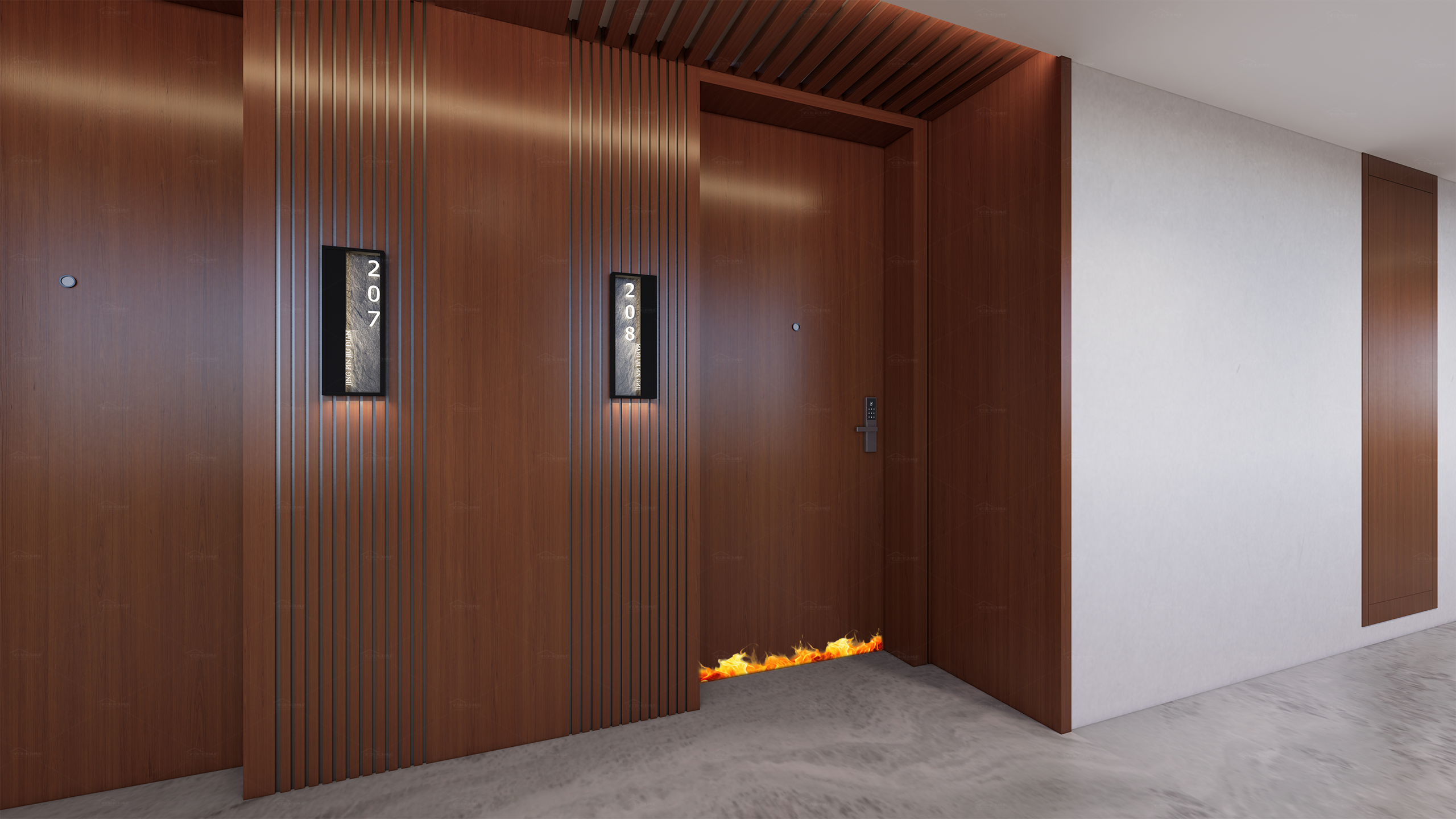What type of door to use for a bathroom?
What type of door to use for a bathroom?
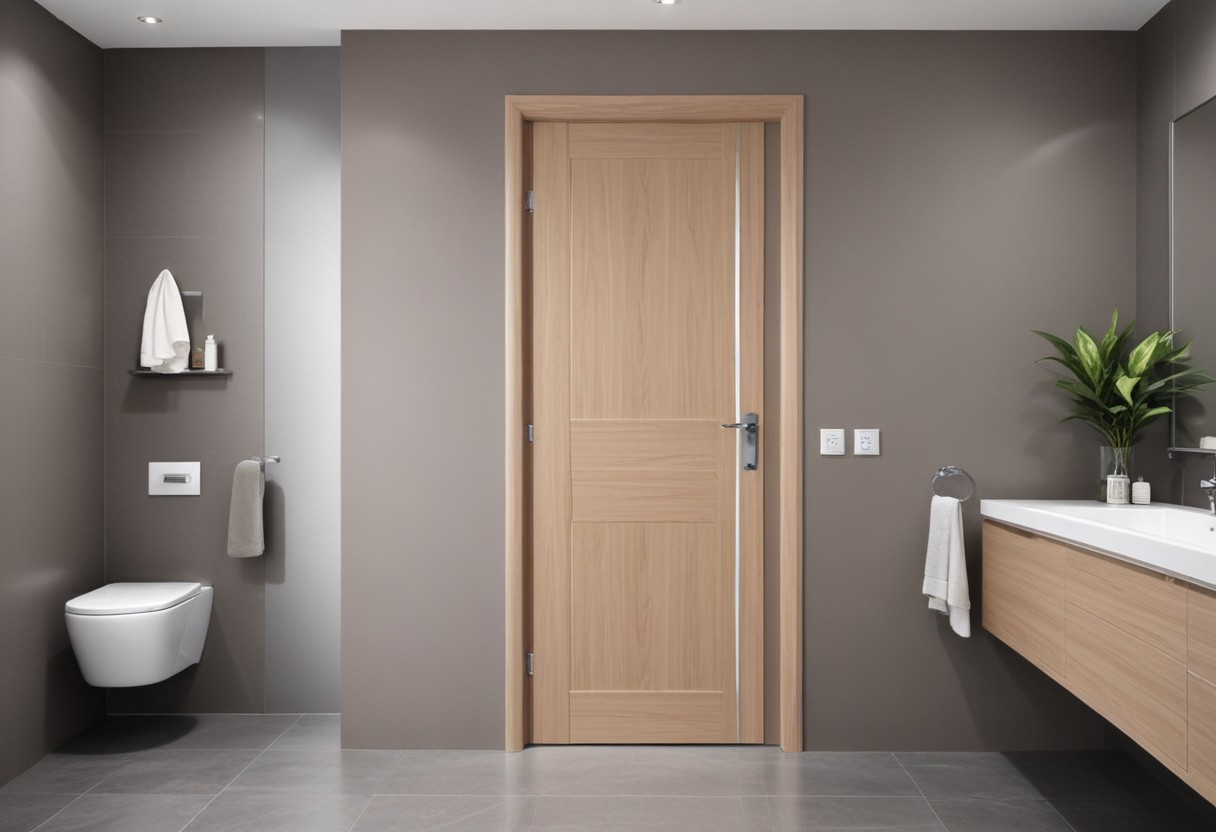
Introduction to Bathroom Doors
When designing or renovating a bathroom, one often overlooked aspect is the door. A bathroom door is not just a functional element but also an important part of the overall style and atmosphere of the space. Choosing the right bathroom door can transform the look of your bathroom while providing privacy and durability. Whether upgrading your existing door or installing a new one, the right choice makes all the difference.
Why Choosing the Right Bathroom Door Matters?
The bathroom is a place where we expect comfort and privacy. A bathroom door plays a crucial role in maintaining that privacy while contributing to the room’s aesthetic appeal. By selecting the right door, you can ensure that the space is functional and visually pleasing.
A well-chosen bathroom door can also help in controlling humidity. Bathrooms, especially small ones, are prone to moisture buildup, so choosing a door made from moisture-resistant materials like PVC or treated wood is key. This helps avoid warping, mold, and mildew, common problems in bathroom environments.
Moreover, the door you pick can significantly impact the layout and flow of your bathroom. A traditional swinging door might take up too much space in a small bathroom, whereas a sliding or pocket door can save valuable room. Additionally, the door style can either complement or clash with the rest of your bathroom decor, so it’s important to pick one that fits the vibe you’re going for.
Factors to Consider When Selecting a Bathroom Door
When deciding on the perfect bathroom door, several important factors must be remembered. Here are a few key considerations that will guide your choice:
1. Space and Size of the Bathroom
The size and layout of your bathroom play a major role in your door selection. For smaller bathrooms, consider doors that don’t swing out, such as sliding or bi-fold doors. These options maximize space and are great for tight areas. A traditional swing door may work well if your bathroom is larger, offering a classic look with easy access.
2. Privacy Needs
Bathrooms require privacy, so choosing a door that ensures you feel secure while using the space is important. Glass doors can be a stylish option, but if you prefer more privacy, frosted or textured glass is a better choice. You can also use wooden doors with solid panels to block out light and sound.
3. Material Durability
Since bathrooms are high-moisture areas, the material you choose for your bathroom door must be durable and resistant to water damage. Wood can be a great option if properly sealed and treated, but other materials like PVC or fiberglass are more water-resistant. Select a material that will withstand your bathroom’s humidity and temperature fluctuations.
4. Aesthetic Appeal
The look of your bathroom door should blend with the rest of your bathroom decor. The door should match the overall design theme, whether you’re going for a modern, rustic, or traditional style. A sleek, frameless glass door might be ideal for a minimalist bathroom. If you prefer a vintage look, a classic wooden door with intricate details may suit your taste.
5. Budget
Your budget will also influence your choice of door. While materials like wood or metal can be more expensive, budget-friendly options such as vinyl or composite materials offer great durability without breaking the bank. It’s essential to balance cost and quality, ensuring you get a long-lasting door within your price range.
6. Ease of Use
Make sure the door is easy to operate. You don’t want to deal with heavy or cumbersome doors in a bathroom, especially when your hands are wet. Sliding doors or bi-fold doors often provide a smoother and more convenient option, particularly in smaller spaces. Pay attention to the door handle or locking mechanism, ensuring it’s easy to use but secure.
By considering these factors—space, privacy, material durability, aesthetics, budget, and ease of use—you can confidently select the best bathroom door, ensuring it will stand the test of time while complementing your overall design.
Types of Bathroom Doors
Choosing the right bathroom door is essential for both functionality and style. Various types of doors are available, and each offers its benefits and drawbacks depending on your bathroom’s size, layout, and design preferences. Let’s look at the traditional swing door, a classic choice for many bathrooms.
Traditional Swing Doors
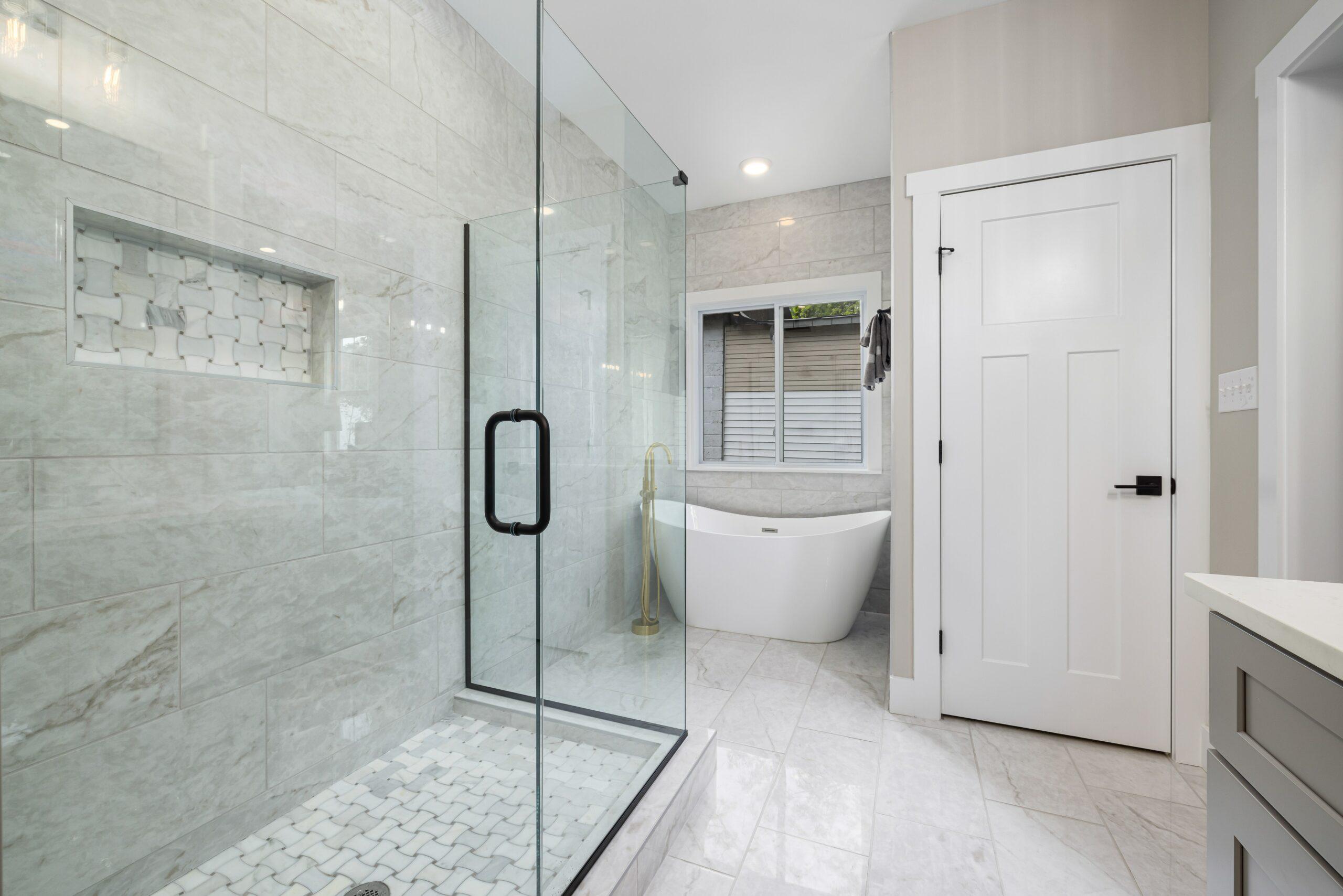
A traditional swing bathroom door is the most common option found in homes. These doors are hinged on one side and swing open and closed like a standard door. While this design is simple and widely available, it’s important to understand when it works best and its limitations.
Pros and Cons of Swing Doors for Bathrooms
Pros:
1. Classic Look
Swing doors are timeless and can complement almost any bathroom style, whether modern, rustic, or traditional. They offer a familiar aesthetic that works well in most home decor.
2. Easy to Install
Swing doors are straightforward, and most people can manage them with a few basic tools. This makes them a great choice for DIY enthusiasts.
3. Affordability
Swing doors are often more affordable than complex options like pocket or sliding doors. If you’re on a budget, this is an excellent way to add a functional door to your bathroom without spending too much.
4. Wide Range of Materials and Styles
Swing doors are available in various materials, from wood to glass to metal. This versatility means you can choose a door that best fits your bathroom’s aesthetic and your specific needs, like privacy or durability.
Cons:
1. Space Requirements
One of the main drawbacks of swing doors is that they need plenty of space to open. In smaller bathrooms, a swing door may take up valuable room, making it harder to move around, especially if the bathroom is narrow. If space is limited, this might not be the best option.
2. Not Ideal for Small Bathrooms
In tight spaces, the door’s swing can interfere with other bathroom fixtures or even block the entryway, which can be inconvenient. You might want to explore sliding or bi-fold doors for compact bathrooms instead.
3. Increased Risk of Damage
Since swing doors are constantly opened and closed, they can be more prone to wear and tear over time. Hinges may loosen, and the door may become misaligned, especially in high-moisture environments like bathrooms.
Pros and Cons of Swing Doors for Bathrooms
When choosing a swing bathroom door material, it’s crucial to consider durability, moisture resistance, and aesthetic appeal. Here are some of the best materials for bathroom swing doors:
1. Wood
Wood is a popular choice for bathroom swing doors due to its classic, warm appearance. However, wood can absorb moisture, which may lead to warping or rotting over time. To avoid this, ensure the wood is properly sealed and treated with a water-resistant finish. Hardwood options, like oak or teak, are more durable in damp conditions.
2. Glass
Glass swing doors are sleek and modern, allowing light to flow into your bathroom. They can be clear, frosted, or textured to provide varying levels of privacy. Frosted glass is a particularly good choice for bathrooms, offering privacy while letting natural light in. Tempered glass is also recommended for safety and durability, especially in bathrooms.
3. PVC or Vinyl
If you’re looking for a low-maintenance, moisture-resistant option, PVC or vinyl swing doors are a solid choice. These materials are highly resistant to water, mold, and mildew, making them ideal for bathrooms with high humidity. Additionally, PVC and vinyl doors are usually lightweight and easy to clean, a big bonus in a space like the bathroom.
4. Composite Materials
Composite materials, such as MDF (Medium Density Fiberboard), offer a great balance of affordability and durability. These materials are often treated to resist moisture and are available in various finishes, from wood-like veneers to solid colors. Composite doors tend to be more stable in humid conditions than pure wood.
5. Aluminum or Metal
For a more modern, industrial look, metal or aluminum doors work well in contemporary bathrooms. These doors are extremely durable and resistant to moisture. While they may not offer the warmth of wood, they provide a sleek and modern appearance that can elevate the look of your bathroom.
By carefully selecting the right material for your bathroom swing door, you can ensure that it will last for years while enhancing your space’s functionality and aesthetics. Consider your bathroom’s size, moisture levels, and overall style to make the best choice.
Sliding Bathroom Doors
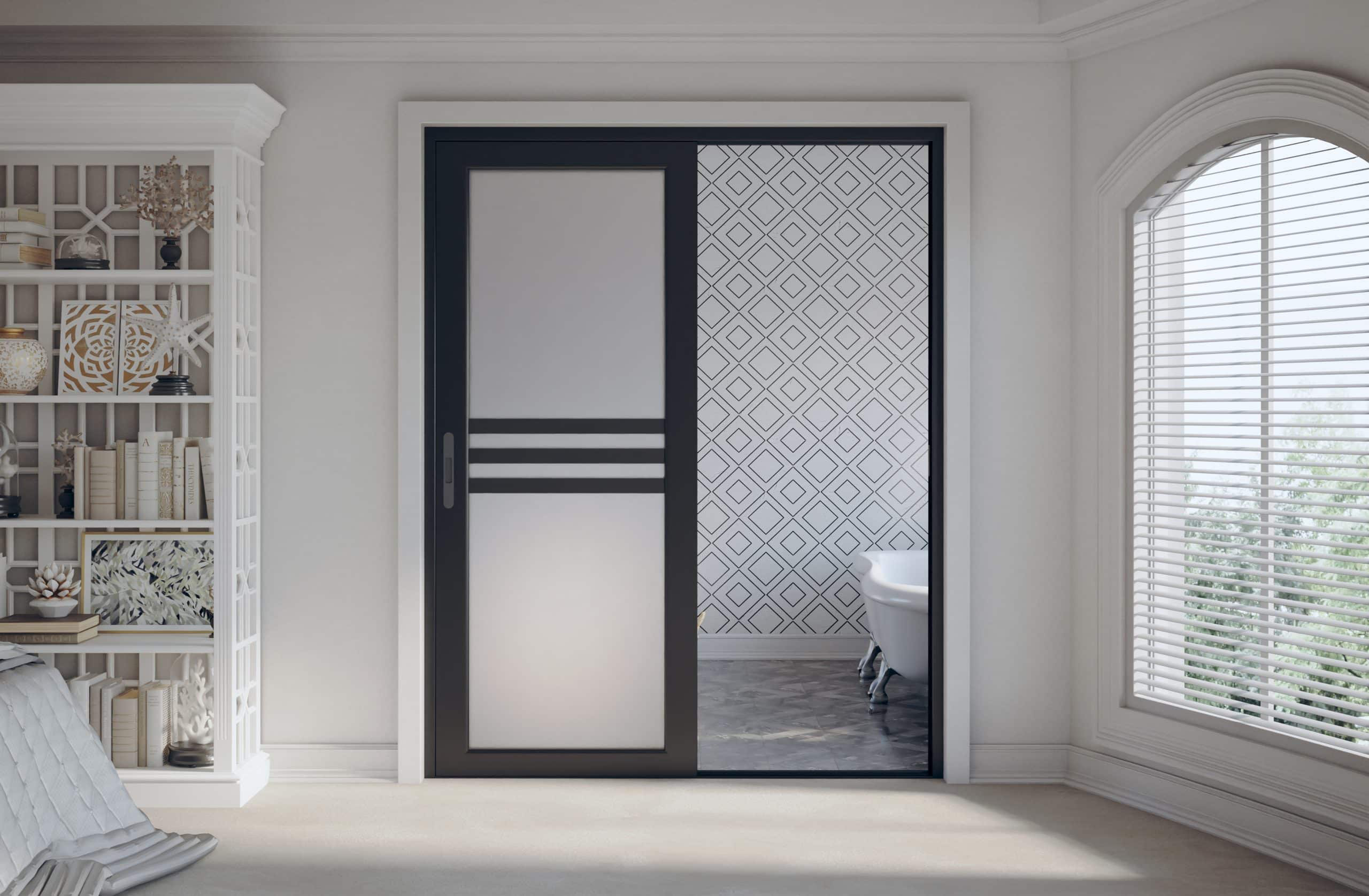
Sliding bathroom doors are sleek and functional. These doors slide smoothly along a track, either inside the wall or outside, without swinging out into the room. This makes them an ideal choice for bathrooms where space is at a premium. Whether you have a small powder room or want to create a modern, open feel in a larger space, sliding doors can be an excellent solution.
Space-Saving Benefits of Sliding Doors
One of the biggest advantages of sliding bathroom doors is their ability to save space. Traditional swing doors require enough room to open fully, which can be problematic in smaller bathrooms. With a sliding door, you don’t need to worry about clearing space for it to swing open, making it easier to move around the room.
In a compact bathroom, you can maximize every inch of space. For example, with a sliding door, you won’t need to move around the door to get in or out, leaving more room for other features, such as storage or a larger vanity. Sliding doors are especially useful for narrow bathrooms where a traditional door might block the entrance or interfere with the layout.
Furthermore, sliding doors create a more open and seamless flow between spaces, making the bathroom feel bigger and more airy. This can be especially beneficial if your bathroom is connected to a larger living area or you want to create a more modern, minimalist aesthetic. The ability to save space without compromising on style or function is why sliding bathroom doors have become a favorite for so many.
Materials and Styles for Sliding Doors
Sliding bathroom doors come in various materials and styles, allowing you to customize the look and feel of your bathroom. Here are some of the most popular materials for sliding doors:
1. Glass
Glass sliding doors are modern and stylish, allowing light to flow freely between the bathroom and other spaces. Frosted or textured glass provides privacy while letting light in, making it a popular bathroom choice. Clear glass is ideal for a sleek, contemporary look, while frosted glass offers more privacy, essential in a bathroom setting.
2. Wood
Wooden sliding doors add a touch of warmth and elegance to a bathroom. They are available in a wide range of finishes, from light oak to deep mahogany, making it easy to find a style that matches your bathroom’s decor. Wood is a natural insulator, which can also help with soundproofing in a shared bathroom. However, it’s essential to treat wooden doors with water-resistant finishes to protect them from moisture damage.
3. PVC or Vinyl
For a low-maintenance option, PVC or vinyl sliding doors are durable and water-resistant, making them perfect for bathroom environments. These materials are lightweight, easy to clean, and highly resistant to mold and mildew, which can be a concern in humid bathroom spaces. PVC sliding doors come in various colors and finishes, from sleek white to wood-effect designs, offering versatility for different bathroom themes.
4. Aluminum or Metal
Sliding doors made from aluminum or metal give the bathroom a sleek, industrial look. They are highly durable and water resistant, making them an excellent choice for bathrooms with high humidity. Metal sliding doors are typically available in matte or brushed finishes, adding a modern edge to your bathroom design.
5. Composite Materials
Composite sliding doors are another excellent option for bathroom use. These doors are typically made from a blend of materials like MDF and laminate, offering a sturdy yet lightweight door resistant to moisture. They also come in various styles and finishes, from wood-look veneers to solid colors, making them versatile and stylish.
When choosing a material for your sliding bathroom door, it’s important to consider both its appearance and practicality. For example, if you value privacy, frosted glass or solid wood may be your best option. PVC or vinyl might be a better fit if you want something low-maintenance and durable. The key is to find a material that complements your bathroom’s design while ensuring it can handle the unique demands of the space, such as moisture and humidity.
Sliding bathroom doors offer a stylish, space-saving solution for modern bathrooms. Whether you choose a glass door for its transparency, wood for its warmth, or PVC for its durability, a sliding door can elevate your bathroom’s look while saving valuable space.
Bi-Fold Bathroom Doors
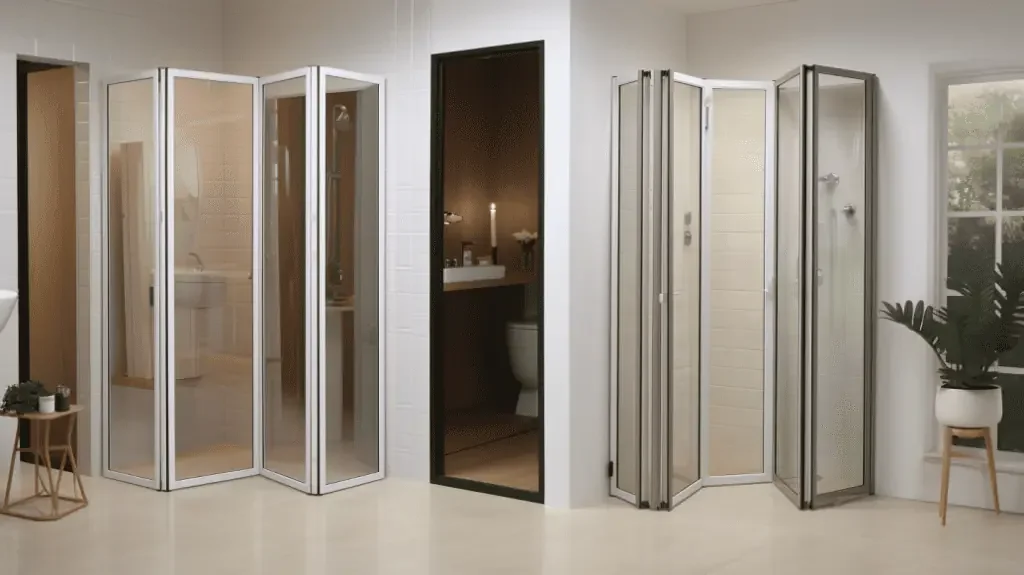
Bi-fold bathroom doors have two panels that fold and stack to one side. This design saves space by eliminating the need for the door to swing open or slide along a track. Bi-fold doors are typically used in bathrooms where maximizing available space is crucial, and they offer a modern, clean look that fits a variety of bathroom styles.
Advantages of Bi-Fold Doors in Small Bathrooms
When selecting a material for bi-fold bathroom doors, it’s important to consider factors like moisture resistance, durability, and aesthetic appeal. Here are some ideal materials for bi-fold doors that work well in bathrooms:
1. Wood
Wood can be a great choice for bi-fold bathroom doors, especially if you want a warm, natural look. However, ensuring the wood is treated for moisture resistance is crucial. Solid hardwood, such as oak or mahogany, can handle bathroom humidity better than softer woods. For extra durability, look for wood doors with a water-resistant finish or laminate wood doors that offer a wood-like appearance without the same moisture risks.
2. Glass
Glass bi-fold doors are perfect for creating a light, airy feel in your bathroom. Frosted glass, in particular, provides privacy while still allowing natural light to flow through. Glass doors are great for smaller bathrooms because they help the space feel less enclosed. Tempered glass is the safest option as it’s strong and resistant to breakage, making it ideal for high-moisture environments like bathrooms.
3. PVC or Vinyl
PVC or vinyl bi-fold doors are excellent for a low-maintenance, durable option. These materials are moisture-resistant and highly durable, making them perfect for bathroom humidity and fluctuating temperatures. PVC and vinyl bi-fold doors are also easy to clean, a major advantage in a space like the bathroom requiring regular upkeep. They are available in various colors and finishes, from sleek modern designs to wood-look options.
4. Composite Materials
Composite doors, made from wood fibers and resin, offer an affordable and durable alternative to solid wood. Composite bi-fold doors are resistant to water damage, don’t warp or crack as easily as wood, and are generally more lightweight, making them easier to operate. They are also available in various styles, from smooth, contemporary finishes to textured options that mimic the look of natural wood.
4. Composite Materials
Composite doors, made from wood fibers and resin, offer an affordable and durable alternative to solid wood. Composite bi-fold doors are resistant to water damage, don’t warp or crack as easily as wood, and are generally more lightweight, making them easier to operate. They are also available in various styles, from smooth, contemporary finishes to textured options that mimic the look of natural wood.
5. Aluminum
If you’re going for a more industrial or modern look, aluminum bi-fold doors are an excellent choice. They are extremely durable, resistant to moisture, and lightweight, which makes them easy to fold. Aluminum doors are perfect for a sleek, minimalist aesthetic and work well in contemporary bathrooms. However, they may not provide the warmth of wood, so they’re best suited to more modern design schemes.
Choosing the right material for your bi-fold bathroom door will depend on your bathroom’s specific needs, such as durability, privacy, and design preferences. Whether you opt for the natural elegance of wood, the transparency of glass, or the durability of PVC, a bi-fold door material suits every bathroom style and function.
Pocket Doors for Bathrooms
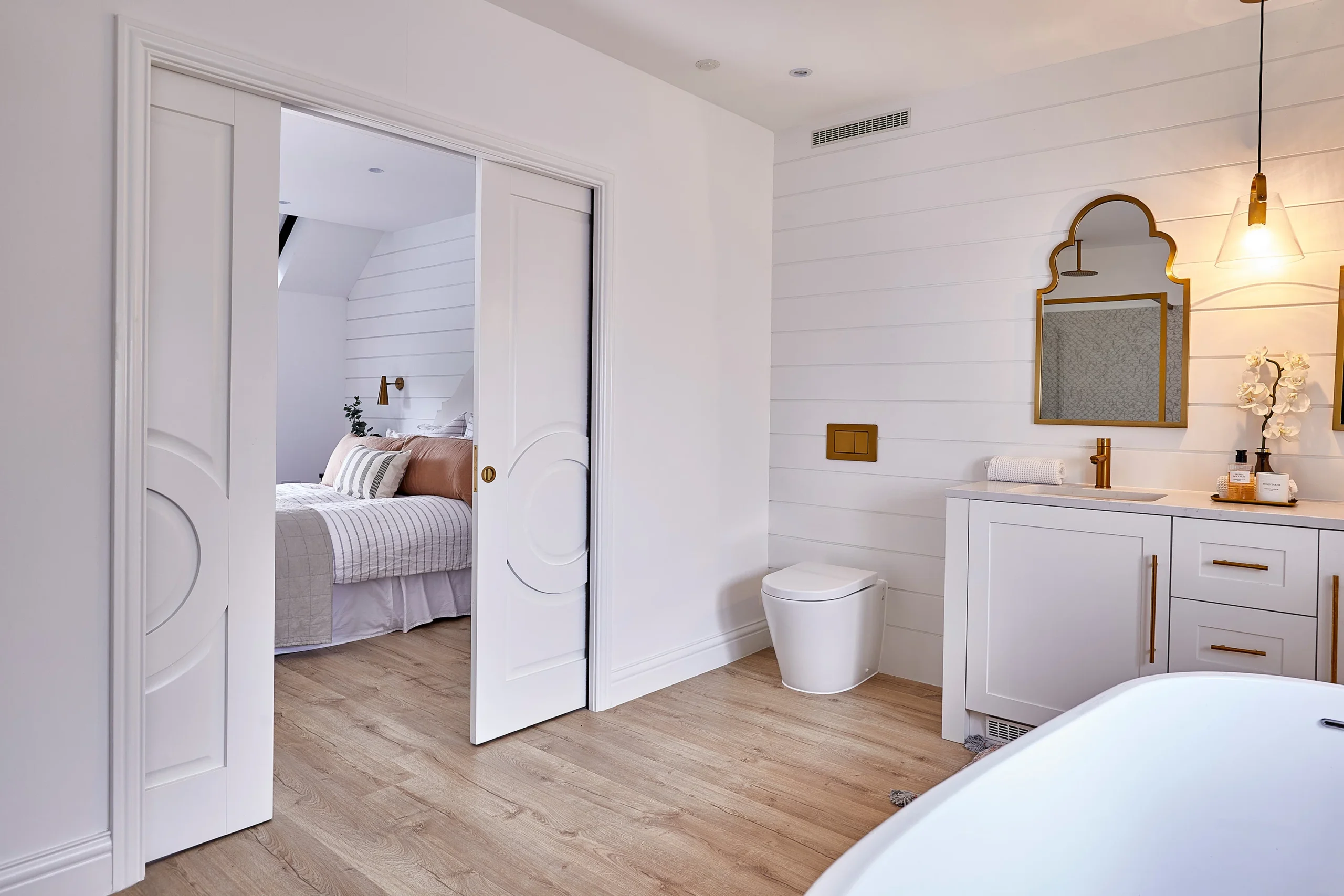
Pocket doors are designed to slide into a pocket within the wall, allowing the door to disappear when opened completely. This door type is ideal for bathrooms, especially when floor space is limited or you want a more modern, minimalist look. Unlike traditional swing doors, pocket doors don’t require any space to swing open, making them perfect for tight bathrooms or rooms with limited clearance.
How Pocket Doors Maximize Bathroom Space?
The main benefit of pocket bathroom doors is their ability to free up valuable space. Traditional swing doors need enough room to open fully, which can be challenging in a small bathroom. Pocket doors, however, slide into the wall, taking up no additional space when opened. This makes them ideal for bathrooms where you want to maximize every inch of space.
In bathrooms with limited square footage, the space-saving feature of pocket doors is a game-changer. You can place furniture, storage units, or other fixtures with no door swinging into the room. This extra space also allows for easier movement, making the bathroom feel less cramped and more open. The door’s ability to “disappear” also contributes to a more seamless flow between your bathroom and adjacent rooms, which can be especially beneficial in small apartments or homes.
Another advantage is that pocket doors can improve your bathroom’s overall layout and functionality. A traditional swinging door in narrow bathrooms can block access to other areas, while a pocket door can slide open without obstructing the flow. It creates a clean, open entryway that feels less confined, making the bathroom appear larger and more spacious than it is.
When to Consider Pocket Doors?
While pocket doors are highly functional, they’re not always the best option for every bathroom. Understanding when they are the right fit for your space is important. Here are some scenarios where you should consider installing pocket doors:
1. Small or Narrow Bathrooms
A pocket door is a great solution if your bathroom is on the smaller side or has limited space for a traditional door. Since it doesn’t need extra room to open, it can maximize the useable space, leaving more room for movement and other elements like a larger sink or additional storage.
2. Bathrooms with Limited Clearance
In bathrooms where the door might interfere with other fixtures or furniture, pocket doors eliminate this problem. For instance, if your bathroom has a tub or a shower that extends close to the door, a traditional door may block access or feel cramped. A pocket door allows full access without the need for extra clearance space.
3. Aesthetic Appeal
Pocket doors offer a sleek, modern look that can elevate the design of your bathroom. Pocket doors are a great fit if you’re aiming for a minimalist or contemporary design. They provide clean lines and a streamlined appearance, creating a sense of openness and sophistication. Additionally, pocket doors are hidden inside the wall and contribute to a clutter-free, tidy look.
4. Accessibility Needs
If you have mobility issues or want to future-proof your bathroom, pocket doors can be ideal. Since they slide open easily, they don’t require the same effort as swing doors, making them easier for individuals with limited strength or mobility.
5. When You Want to Maximize the Entry Space
In bathrooms that require wider entryways for accessibility or design purposes, pocket doors can help. They open fully and don’t block the doorway, ensuring you can maximize the space. This is particularly helpful in shared bathrooms or bathrooms designed to accommodate multiple people simultaneously.
Dutch Doors for Bathrooms
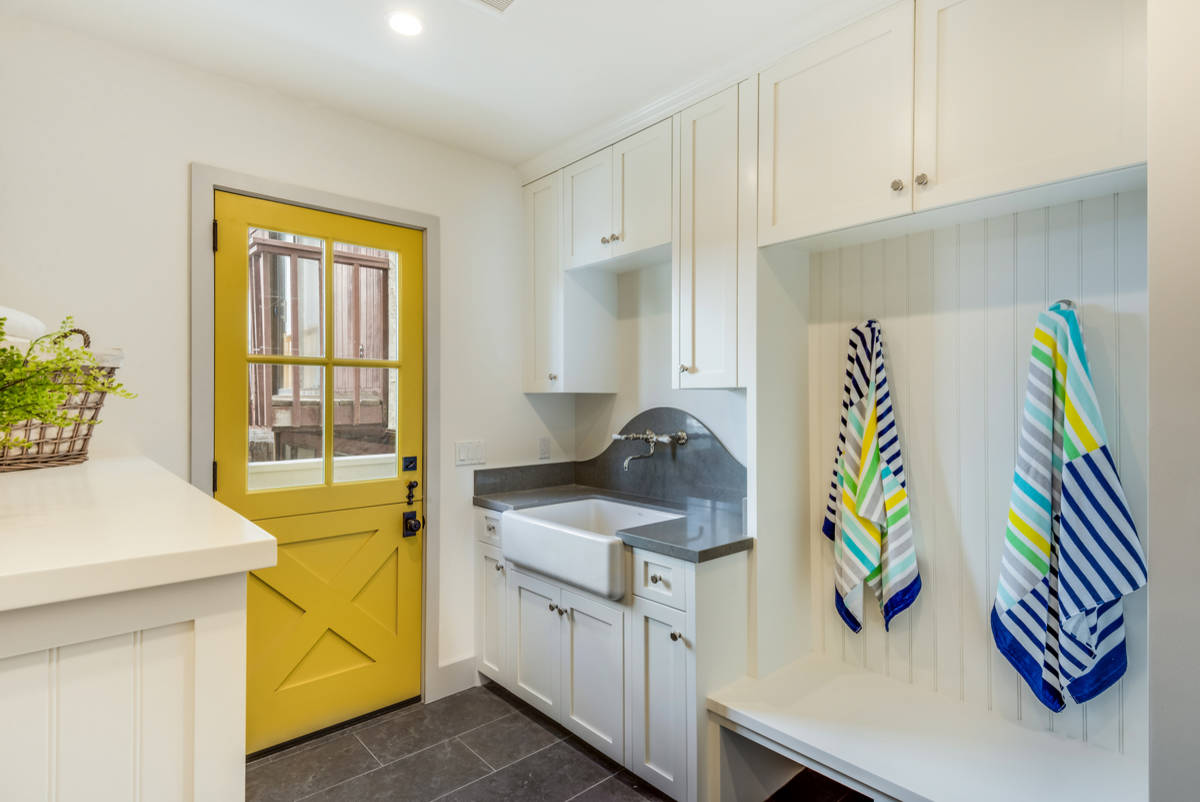
Dutch doors are a distinctive style of bathroom door split horizontally into two sections. The top half can be opened independently of the bottom, giving you more flexibility when using the space. While this type of door is often associated with country homes or cottages, Dutch doors can also add a touch of character and practicality to modern bathrooms.
Why Choose a Dutch Door for Your Bathroom?
1. Improved Ventilation and Natural Light
One of the main reasons to choose a Dutch door for your bathroom is the ability to improve ventilation. The top half of the door can be left open, allowing fresh air to flow into the room, which helps reduce moisture buildup. This is particularly beneficial in bathrooms with high humidity, as better airflow can prevent mold and mildew growth. Additionally, keeping the top half of the door open lets in natural light, brightening your bathroom without sacrificing privacy.
2. Privacy with Flexibility
Another advantage of Dutch doors is their privacy while still providing flexibility. You can open the top section for light and air without exposing the entire bathroom. This is especially useful for shared bathrooms or bathrooms with young children or pets, as it allows you to maintain some degree of privacy while still keeping an eye on the space. This makes Dutch doors an excellent choice for families who need a balance of openness and seclusion.
3. Unique Aesthetic Appeal
Dutch doors can add a unique, rustic charm to your bathroom. Their classic design works well with various styles, from traditional and country-inspired bathrooms to modern, eclectic designs. The two-part structure can also make the door a focal point in your bathroom’s design, enhancing its overall character. If you want something that stands out from traditional door options, a Dutch door can give your bathroom a distinctive, welcoming feel.
4. Convenience in Small Spaces
In small bathrooms, Dutch doors offer the convenience of space-saving while still providing full functionality. Since the top section can be opened without the bottom section, you can open the door without worrying about it swinging into the room. This makes Dutch doors ideal for bathrooms with limited space or in areas where you don’t want a full door taking up valuable room.
Best Materials and Designs for Dutch Doors
When selecting materials and designs for a Dutch bathroom door, it’s important to consider factors like durability, privacy, and style. Here are some of the best materials and design ideas for Dutch doors:
1. Wood
Wood is the most traditional material for Dutch doors, offering a natural and warm aesthetic. Hardwood options, such as oak, maple, or pine, are durable and can withstand the wear and tear of a bathroom environment, especially when properly sealed. Wood also provides excellent insulation and helps with soundproofing, which is an added benefit in shared bathrooms. You can choose a solid wood finish for a classic look or a painted wood door to match your bathroom’s color scheme.
2. Composite Materials
For a more cost-effective option, composite materials like MDF (Medium Density Fiberboard) can be great. These materials are designed to mimic the look of wood while being more moisture-resistant. Composite Dutch doors are durable and can be finished in various colors or textures, offering flexibility in design. Plus, they require less maintenance than solid wood, making them a practical choice for bathrooms with common moisture and humidity.
3. Glass Panels
If you want to enhance the light flow into your bathroom, consider incorporating glass panels into the top half of your Dutch door. Glass allows natural light to enter while maintaining privacy. Frosted or textured glass can add an extra layer of privacy. At the same time, letting in light works especially well in bathrooms with limited natural light. Glass adds a modern, sleek touch to the classic Dutch door, blending traditional design with contemporary style.
4. Metal Accents
Metal accents can be added to a Dutch door for a more industrial or modern look. Consider a metal frame or hardware, such as handles or hinges, to give the door a sleek, minimalist edge. Aluminum or steel frames are durable and rust-resistant, making them ideal for bathroom environments. Metal accents can give the Dutch door a sophisticated, modern twist that works well in contemporary bathrooms.
5. Custom Designs
Many designers offer custom Dutch doors if you’re looking for something truly unique. You can personalize the design to fit your bathroom’s style and specific needs. Whether you want a door with more decorative elements, different panel arrangements, or a custom color, a bespoke Dutch door can elevate your bathroom’s aesthetic and functionality.
Best Materials for Bathroom Doors
Wood is a classic choice for bathroom doors, offering a natural, warm look that complements many bathroom designs. However, when choosing wood bathroom doors, it’s important to consider their suitability for the humid bathroom environment. Let’s dive into the benefits and limitations of wood doors and how to treat them for optimal moisture resistance.
Wood Bathroom Doors

Wood bathroom doors are favored for their beauty and durability. They can bring a rich, natural texture to your bathroom, whether for a rustic farmhouse style or a more traditional look. From oak to mahogany, the variety of wood types allows you to match the door with your bathroom’s aesthetic. Wood doors also come in different finishes, such as stained or painted, providing flexibility to suit various design preferences.
However, wood in the bathroom is not without its challenges. Bathrooms are naturally humid spaces, and this moisture can affect wood over time if not properly treated. Despite this, many homeowners still choose wood bathroom doors because of their timeless appeal and the elegance they add to the space.
1. Benefits and Limitations of Wood Doors in Bathrooms
Benefits of Wood Bathroom Doors
1. Aesthetic Appeal
Wood doors offer a warm, classic look that complements nearly any bathroom style. Wood bathroom doors can fit seamlessly, whether your bathroom features a contemporary design, traditional charm, or rustic vibes. They help create a cozy, inviting atmosphere, especially important in a private space like a bathroom.
2. Durability
When well-maintained, wood doors are incredibly durable. They can withstand normal wear and tear, offering long-lasting use. Hardwoods, such as oak, mahogany, or walnut, are particularly strong and can hold up well against daily use, making them a reliable option for bathroom doors.
3. Insulation and Soundproofing
Wood is a great insulator, helping to regulate bathroom temperatures by reducing heat loss. It also provides excellent soundproofing, which is especially beneficial in shared bathrooms or homes with multiple family members. This can create a more peaceful, private atmosphere.
Limitations of Wood Bathroom Doors
1. Susceptibility to Moisture Damage
One of the biggest challenges with wood bathroom doors is their sensitivity to moisture. The humidity in the bathroom can cause wood to warp, swell, or crack over time. This can make the door difficult to open or close and damage the door’s appearance. Wood can absorb moisture without proper treatment, making it more prone to rot and mildew.
2. Maintenance Requirements
Wood bathroom doors require regular maintenance, especially in humid environments. They need to be sealed or treated properly to prevent moisture absorption. Wood doors can deteriorate quickly without regular care, resulting in costly repairs or replacements.
3. Cost
High-quality wood doors can be more expensive than doors made from other materials, such as MDF or PVC. Additionally, if you want a durable wood door for your bathroom, you’ll likely need to invest in hardwood, which comes at a higher cost.
While wood bathroom doors offer numerous benefits in terms of beauty and durability, it’s important to weigh these against the limitations of bathroom humidity. Proper treatment and maintenance are essential to ensure the longevity of your wood bathroom door.
Wood Treatment for Moisture Resistance
To get the most out of your wood bathroom door, it’s important to treat it for moisture resistance. Here are some tips for properly treating and maintaining wood doors in bathrooms:
1. Seal the Wood
The most effective way to protect your wood bathroom door from moisture is by applying a high-quality sealer. A water-resistant finish creates a barrier that prevents moisture from penetrating the wood. This helps reduce the risk of warping and swelling. You can use a polyurethane sealant or a varnish designed for bathroom use. Make sure to reapply the sealer as needed to maintain protection.
2. Use Moisture-Resistant Wood
If you’re concerned about moisture damage, choose moisture-resistant woods like teak, cedar, or mahogany. These woods naturally resist moisture and can stand up to the humid conditions of a bathroom better than other types of wood. While these materials can be more expensive, they offer greater longevity and less maintenance.
3. Ventilation and Dehumidifiers
Proper bathroom ventilation is crucial for protecting wood doors from moisture. Ensure your bathroom has an exhaust fan to help reduce humidity levels. Consider using a dehumidifier in particularly humid bathrooms. Lowering the humidity in the room will help prevent the wood from absorbing moisture and keep your door in good condition.
4. Regular Maintenance and Inspection
Regularly check the condition of your wooden bathroom door. Look for any signs of moisture damage, such as discoloration, warping, or peeling paint. If you notice any of these issues, it’s important to address them promptly by resealing or refinishing the door. Keeping the door clean and well-maintained will extend its lifespan and preserve its appearance.
5. Choose the Right Finish
A durable, moisture-resistant finish is key to protecting your wood bathroom door. You can opt for a glossy finish, which creates a smooth, sealed surface that repels water, or a matte finish, which provides a more natural look but still offers some protection. The right finish can also affect the look and feel of your bathroom, so choose one that complements your design preferences.

Glass Bathroom Doors
Glass bathroom doors are a great way to add elegance and openness to your bathroom. They are often used in contemporary and minimalist designs, helping to make smaller spaces feel larger by allowing light to flow freely. Additionally, glass doors can create a sense of continuity between the bathroom and adjoining rooms, making the space feel more connected to the rest of the home.
One of the primary advantages of glass bathroom doors is that they can help with lighting. A clear glass door allows natural light to filter into the bathroom, which can be especially valuable in rooms with limited windows. However, the type of glass you choose becomes very important because privacy is a concern in bathrooms.
Clear vs. Frosted Glass for Privacy
When choosing glass for your bathroom door, you must consider privacy. Clear glass may look stunning, but it can also expose the interior of your bathroom. For many, privacy is essential, and clear glass may not offer the best solution.
1. Clear Glass:
Clear glass offers an open and airy feel, allowing natural light to flood your bathroom. It works particularly well in bathrooms with good privacy already, such as those with frosted windows or those located in areas of the home where there’s no risk of prying eyes. Clear glass can create a spacious and bright ambiance if you don’t mind the lack of privacy or if your bathroom is in a private area of your home.
2. Frosted Glass:
Frosted glass is popular for bathrooms because it balances natural light and privacy. The frosted effect diffuses the light, providing a soft glow while blurring the view into the bathroom. It’s an ideal option for those who want a stylish glass door but still require privacy. Frosted glass can be achieved by sandblasting, acid etching, or applying a frosted film to the glass. It allows you to enjoy the benefits of glass without compromising on seclusion, which is especially important in shared bathrooms.
3. Other Options:
In addition to clear and frosted glass, there are also options for textured glass, which has patterns or designs that add privacy and style. Textured glass diffuses light while adding a decorative element to your bathroom door. You can choose from a wide range of designs, from subtle patterns to bold geometric shapes, allowing you to find a balance between privacy and aesthetics.
Types of Glass Suitable for Bathroom Doors
Not all glass is created equal, especially regarding bathroom doors. Some types of glass are better suited for the moisture-rich bathroom environment than others. Here are the most common types of glass suitable for bathroom doors:
1. Tempered Glass:
Tempered glass is popular for bathroom doors due to its strength and durability. It is heat-treated, making it much stronger than regular glass, and it breaks into small, less dangerous pieces if it shatters. Because of its resistance to thermal shock, tempered glass is perfect for the high-humidity bathroom environment. It’s also highly resistant to scratching, making it a low-maintenance option.
2. Laminated Glass:
Laminated glass consists of two or more layers of glass with a layer of plastic in between. This type of glass is designed to hold together even when it breaks, making it a safer option than standard glass. Laminated glass is also great for sound insulation, which can help reduce noise in your bathroom. Though it’s not as common as tempered glass, it’s still a reliable and safe option for bathroom doors.
3. Low-E Glass:
Low-E (low-emissivity) glass is coated with a thin metal oxide layer that helps reflect heat and UV rays. It’s a great option to keep your bathroom cooler in the summer and prevent heat loss during the winter. Low-E glass can also help protect your bathroom from UV damage, such as fading or discoloration of towels, rugs, and other materials.
4. Tinted Glass:
Tinted glass is another option that can provide both privacy and style. The tinted coating reduces the visible light that passes through, offering added privacy while letting some light into the room. Tinted glass can also help reduce glare and improve the energy efficiency of your bathroom by keeping it cooler during hot days.
5. Mirror Glass:
Mirror glass is a unique option for bathroom doors, especially if you want to create the illusion of space. A mirrored surface on a bathroom door reflects light, making the room appear larger and brighter. However, it’s important to balance this with privacy needs, as mirror glass can be reflective and show the bathroom interior depending on the angle.
6. Smart Glass (Electrochromic Glass):
For the ultimate in high-tech bathrooms, consider smart glass. Smart glass, also known as electrochromic glass, can change from clear to frosted at the touch of a button. This allows you to adjust the level of privacy as needed. It’s perfect for those who want the flexibility to switch between a transparent and opaque door easily.
PVC and Vinyl Doors
PVC (polyvinyl chloride) and vinyl doors are widely used in bathrooms due to their resistance to moisture and affordability. Both materials are synthetic, so they are not prone to issues associated with natural materials like wood, such as swelling or rotting from moisture exposure. PVC and vinyl doors are available in various styles and finishes, making them versatile for multiple bathroom designs.
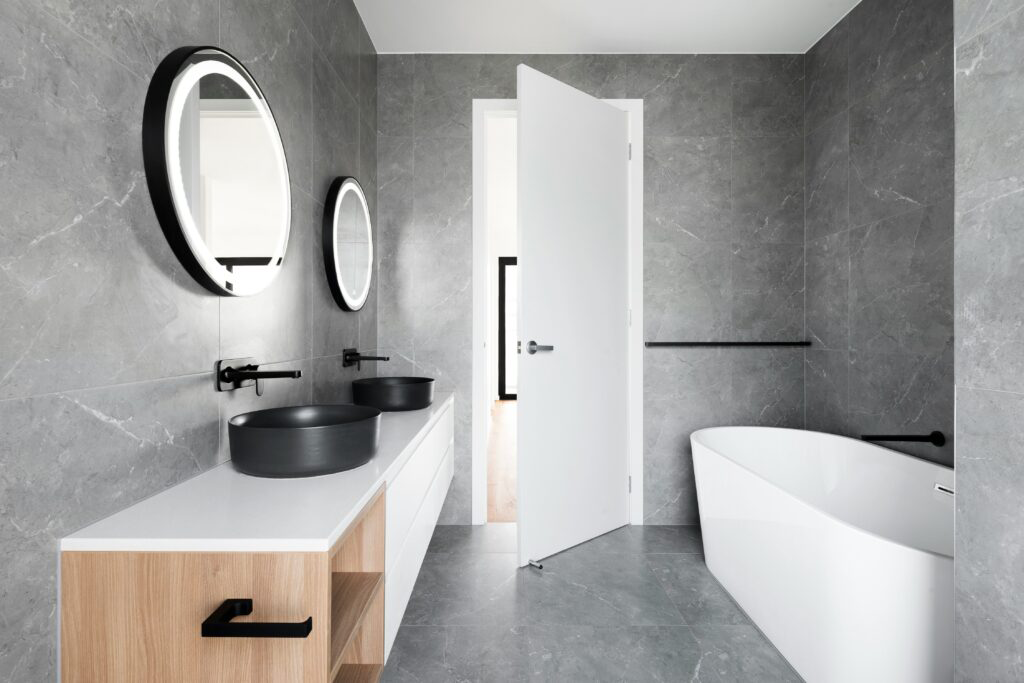
Why PVC is a Popular Choice for Bathroom Doors
1. Moisture Resistance
PVC bathroom doors are highly resistant to water, making them perfect for bathrooms where humidity and moisture levels are often high. Unlike wood, which can warp, swell, or rot when exposed to moisture, PVC doesn’t absorb water. This makes it a long-lasting option for your bathroom door, especially in spaces like showers or areas with poor ventilation.
2. Durability
PVC is a tough material that can withstand daily use and wear. It resists scratches, dents, and fading, keeping your bathroom door looking new for years. The durability of PVC makes it an excellent investment for households with children or pets, where doors may experience more frequent contact.
3. Easy to Maintain
One of the biggest advantages of PVC bathroom doors is their ability to maintain. They don’t require regular painting or sealing like wood doors. A quick wipe-down with a damp cloth is usually all it takes to keep your door clean. Additionally, PVC doesn’t attract dust or allergens, making it a great option for people with sensitivities or respiratory issues.
4. Affordable
PVC doors are more affordable than wood, glass, or metal, making them an attractive choice for homeowners on a budget. Despite the lower cost, PVC doors don’t compromise on performance, offering both practicality and longevity without breaking the bank.
Variety of Styles
PVC bathroom doors come in various styles, from traditional panel doors to sleek, modern designs. You can find PVC doors that mimic the look of wood, providing the aesthetic appeal of natural materials without maintenance. Whether you prefer a simple, minimalist design or something more ornate, PVC offers flexibility to match your bathroom’s decor.
Pros of Vinyl Doors in High-Moisture Areas
1. Water-Resistant
Vinyl doors, like PVC, are inherently water-resistant. In a bathroom where moisture is a constant concern, vinyl is a perfect material to prevent the growth of mold and mildew. These doors won’t warp or deteriorate due to high humidity, making them ideal for bathrooms, especially in areas like showers or near bathtubs.
2. Low Maintenance
Vinyl doors are incredibly easy to care for. Unlike wood doors, they don’t need to be painted or treated with special finishes to resist moisture. Cleaning is simple and requires just soap and water. This low-maintenance feature makes vinyl doors particularly popular among busy homeowners or those seeking a hassle-free option.
3. Durability and Longevity
Vinyl bathroom doors are tough and can withstand years of use. They resist scratching, chipping, and fading, even with constant exposure to moisture. This durability makes vinyl an excellent long-term investment for your bathroom door. Plus, vinyl doors are often made with UV-resistant coatings, which won’t fade from sunlight exposure.
4. Lightweight and Easy to Install
Another advantage of vinyl doors is their lightweight nature. This makes them easier to handle during installation than heavier materials like wood or glass. A DIY enthusiast or a professional can easily install vinyl doors, saving on labor costs if you update your bathroom door.
5. Affordable and Cost-Effective
Vinyl doors are among the most affordable bathroom door options available. They provide great value for money, as they don’t require expensive maintenance or replacement due to moisture damage. Compared to high-end materials like wood or glass, vinyl is often the more budget-friendly choice without compromising functionality.
6. Customization Options
Vinyl doors come in various colors, designs, and finishes, allowing you to customize your bathroom door to suit your style. Whether you prefer a simple, solid color or a textured finish, vinyl offers plenty of options to match your bathroom’s theme. You can even find vinyl doors that mimic the appearance of other materials, such as wood or stone, to achieve the look you desire without the upkeep.
Metal Bathroom Doors
Metal bathroom doors are known for their robustness and long-lasting nature. While they may not be as common as wooden or glass doors, metal options are becoming increasingly popular in contemporary and industrial-themed bathrooms. They can create a sleek, modern aesthetic or add a bit of edge to a more traditional bathroom. But beyond looks, metal doors are built to endure the wear and tear of everyday use in a bathroom setting.
Durability of Metal Doors for Bathroom Use
One of the primary reasons metal is chosen for bathroom doors is its exceptional durability. Unlike wood, metal is not vulnerable to moisture damage such as warping, swelling, or rotting. In a bathroom, where humidity levels can fluctuate drastically, a metal door can withstand constant exposure to steam, water splashes, and damp conditions without losing its integrity.
1. Moisture and Corrosion Resistance:
Modern metal bathroom doors, especially those made from stainless steel or powder-coated steel, are highly resistant to rust and corrosion. This is important because bathrooms are often exposed to high levels of moisture, which can cause damage to doors made from less durable materials. Stainless steel, in particular, is known for resisting rust and staining, making it a top choice for bathrooms.
2. Easy Maintenance:
Metal doors require minimal maintenance compared to wooden doors, which need regular refinishing to prevent damage from moisture. With metal doors, a simple wipe-down with a damp cloth is usually all needed to keep them looking great. Additionally, many metal doors are coated with protective finishes, such as powder coating or galvanization, to prevent scratches and ensure a smooth, durable surface.
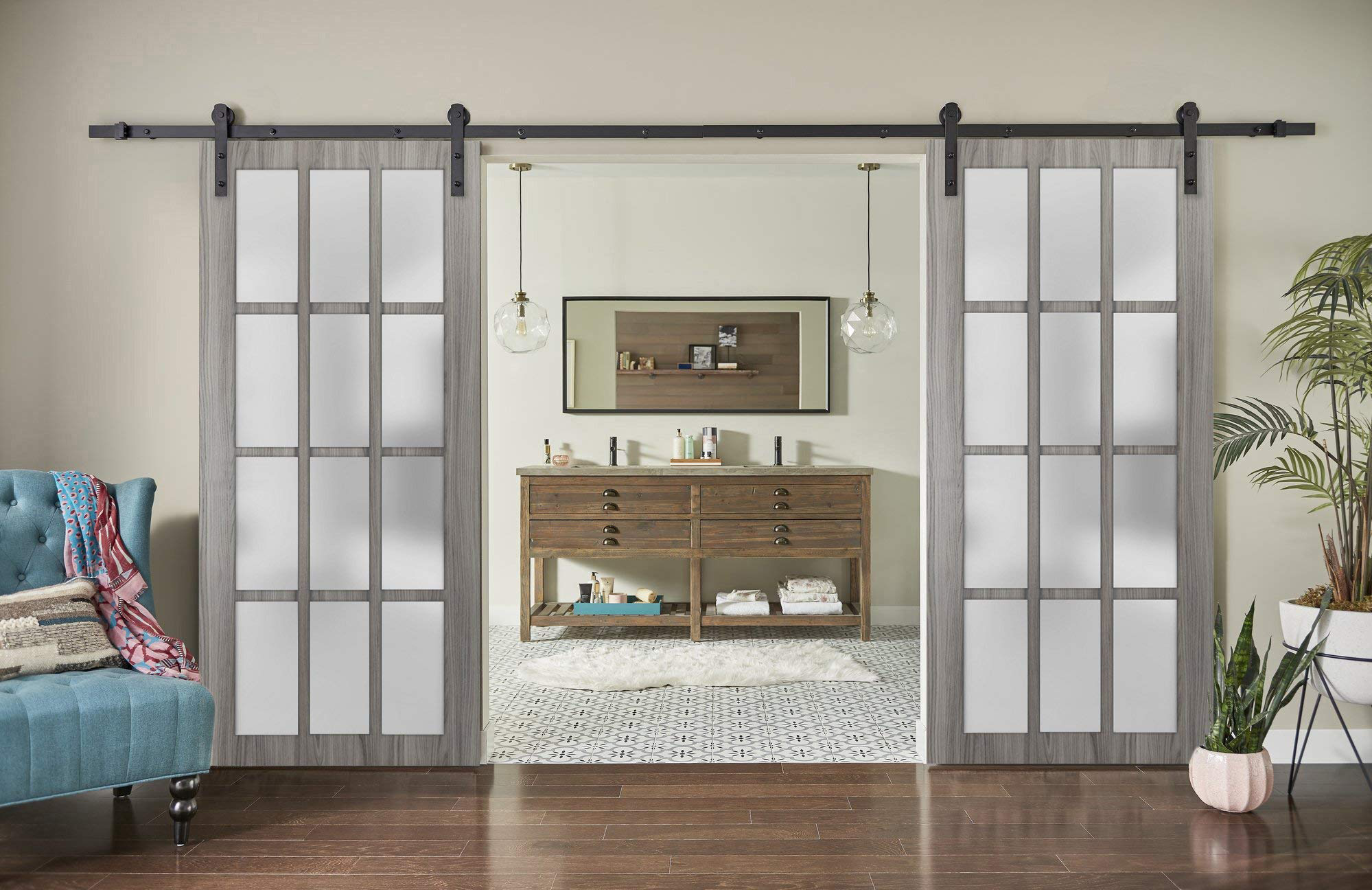
3. Longevity:
Metal bathroom doors can last for decades, especially when properly maintained. Their resistance to wear and tear and ability to handle humid and wet conditions make them a smart long-term investment. They are also less likely to suffer from issues like fading or cracking over time, unlike wood, which can deteriorate due to constant exposure to moisture.
Different Types of Metal Doors for Bathrooms
Several types of metal doors work well in bathroom settings. Each type of metal has unique benefits and can contribute to different styles and functionalities in your bathroom. Here are the most common metals used for bathroom doors:
1. Stainless Steel Doors:
Stainless steel is one of the most popular metals for bathroom doors due to its combination of durability and resistance to moisture. It is highly corrosion-resistant, making it ideal for bathrooms where high humidity levels are often high. Stainless steel bathroom doors are sleek and modern, perfect for contemporary or industrial-themed bathrooms. They are also extremely easy to clean and maintain, making them a practical choice for homeowners.
2. Aluminum Doors:
Aluminum is another great option for bathroom doors. While it is lighter than stainless steel, it still offers excellent durability and resistance to rust. Aluminum doors are often more affordable than stainless steel, making them a budget-friendly choice for homeowners. Aluminum is also highly versatile and can be finished with various coatings to give it a more decorative appearance. Aluminum is a good choice if you’re looking for a lightweight yet durable bathroom door.
3. Powder-Coated Steel Doors:
Powder-coated steel combines the strength of steel with a protective finish that resists corrosion, fading, and scratching. Powder coating is a process where a dry powder is applied to the metal and then baked at high temperatures, resulting in a smooth, durable finish. This makes powder-coated steel doors ideal for bathroom use, as they can handle moisture and daily wear and tear. Powder-coated doors also come in various colors and finishes, making them versatile for bathroom design.
4. Galvanized Steel Doors:
Galvanized steel is coated with a zinc layer to protect it from rust and corrosion. This makes it a strong and durable option for bathrooms where water exposure is common. Galvanized steel doors are often used in industrial or commercial settings but can add an edgy, rustic touch to residential bathrooms. Galvanized steel could be the right choice if you’re going for a more industrial style or need a highly robust door.
5. Copper and Brass Doors:
Some bathrooms use copper or brass doors for a unique, high-end look. These metals offer a distinctive appearance, often with an aged patina that develops over time, adding character and charm. While copper and brass doors are not as common as stainless steel or aluminum, they can be an excellent choice for certain design styles. Remember, though, that these metals may require more maintenance to maintain their appearance, as they are more prone to tarnishing and discoloration.
6. Iron Doors:
Wrought iron doors are another metal option, though they are typically used for decorative purposes. While heavy, iron doors can add a traditional or vintage feel to a bathroom. They are durable but need to be treated to resist rust and corrosion. Iron doors often come with intricate designs and can add a touch of elegance to larger, more traditional bathrooms.
Considerations for Bathroom Door Privacy
Privacy is a top priority when selecting a bathroom door. After all, the bathroom is one of the most private spaces in a home, and you want to ensure that you feel secure and comfortable. Whether your bathroom is small or large, there are several ways to maintain privacy. In this section, we will explore different aspects of bathroom door privacy, including privacy concerns in small bathrooms, glass options for added seclusion, and the role of locks in maintaining security.
How to Maintain Privacy in Bathrooms?
In smaller bathrooms, privacy becomes even more of a concern due to close quarters and the potential for noise or accidental exposure. Here are some ways to keep your bathroom door private while still making the most of the available space:
1. Use Solid Doors:
A solid, non-transparent door is often the best choice for small bathrooms. Solid wood or metal doors can provide a complete barrier against prying eyes, ensuring that no one can see in, no matter the size of the space. These doors ensure full privacy while minimizing any light or sound that may pass through.
2. Consider Pocket or Bi-Fold Doors:
Consider installing a pocket or bi-fold door if you’re tight on space. These options don’t require extra space to swing open, allowing for a more functional layout. Pocket doors slide into the wall, while bi-fold doors fold in half, making them ideal for bathrooms where space is premium. Both door types offer privacy without compromising on space.
3. Add Curtains or Blinds:
If your bathroom door includes a glass element, such as a small window or partial glass panel, you can maintain privacy by adding curtains or blinds. Simple roller blinds or frosted curtains can block the view without obstructing natural light. This is a quick and easy solution for maintaining privacy without needing a full door replacement.
4. Opt for Thick, Heavy Doors:
Heavy, thick doors can also provide an added layer of privacy by reducing sound transmission. Materials such as solid wood or composite doors help muffle noise, ensuring that sounds from within the bathroom are less likely to carry outside. This is especially useful in homes with thin walls or multiple bathrooms close to each other.
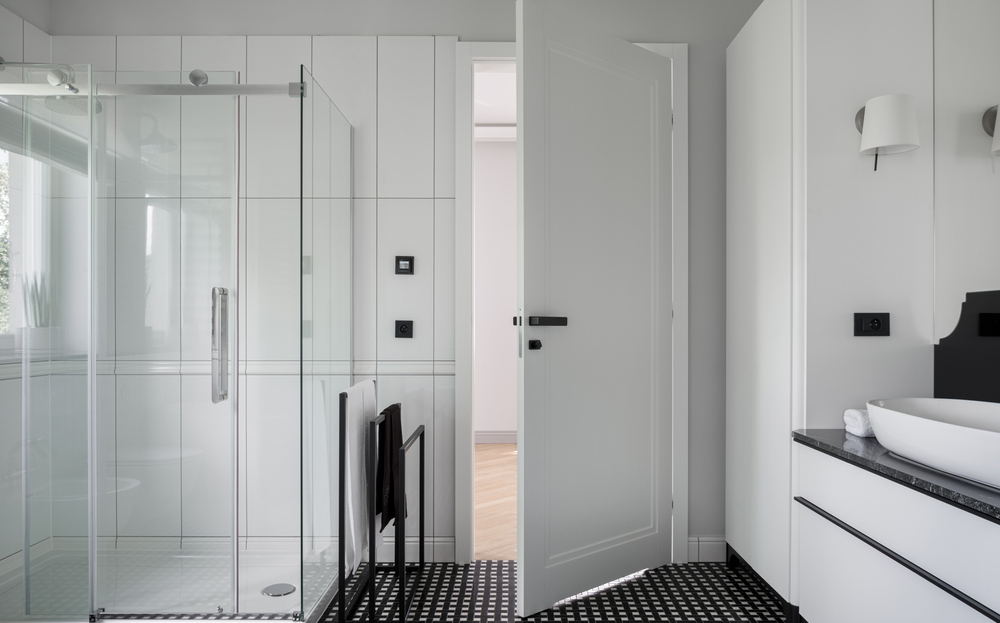
Options for Frosted or Textured Glass
If you prefer a glass door but want to maintain privacy, frosted or textured glass is an excellent option. These glass types allow light into the bathroom while obscuring the view, balancing privacy and brightness.
1. Frosted Glass:
Frosted glass has a translucent finish that diffuses light but prevents clear visibility. This makes it perfect for bathroom doors, as it allows natural light to filter through while maintaining a private atmosphere. You can opt for full frosted glass doors or install frosted glass panels on the top or bottom of a standard door. This ensures that the space feels open and airy yet still offers privacy.
2. Textured Glass:
Textured glass is another popular choice for bathroom doors. It comes in various patterns, such as bubbles, ripples, or geometric designs, that distort the view and prevent anyone from seeing through clearly. Textured glass allows for privacy without completely blocking out the light. It’s a great solution if you’re looking for something a bit more decorative but still functional.
3. Tinted Glass:
In addition to frosted and textured glass, tinted glass is another option to provide extra privacy. The tinted finish reduces the transparency of the glass, making it harder to see inside. It can also add a sleek, modern look to your bathroom. However, remember that tinted glass may reduce the amount of natural light that enters, so you may need to balance this with proper lighting inside the bathroom.
4. Glass with Privacy Film:
Applying a privacy film is another affordable and customizable option for bathroom doors with glass panels. This film can be applied directly to the glass to create a frosted or opaque effect, making it harder to see. Privacy films are available in various designs and levels of opacity, allowing you to choose the right amount of privacy while maintaining a stylish look.
The Role of Locks in Bathroom Doors
While choosing the right door material and design is essential for privacy, the lock you choose for your bathroom door plays a crucial role in security. A reliable lock ensures your bathroom remains a private space where you can feel secure.
1. Privacy Latch:
A privacy latch is one of the most common locks for bathroom doors. This type of lock typically features a simple push-button mechanism inside the door. It provides a basic level of security and privacy, ensuring that the door remains closed while you’re inside. Privacy latches are easy to install and use, making them an affordable and practical option for most bathrooms.
2. Turn-Button Lock:
A turn-button lock is another popular choice for bathroom doors. This lock features a small knob that you turn from the inside to secure the door. It’s simple and effective, providing peace of mind without the complexity of a keyed lock. Turn-button locks are ideal for bathrooms that family members or guests primarily use, as they don’t require a key and can be easily unlocked in an emergency.
3. Keyed Locks:
Consider installing a keyed lock for extra security, especially in bathrooms shared by multiple people or those with high foot traffic. A keyed lock provides a higher level of security, as it requires a key to unlock. While it’s not as common in residential bathrooms, it may be appropriate for larger homes, public restrooms, or commercial spaces where additional privacy and security are necessary.
4. Deadbolts and Slide Bolts:
Deadbolts or slide bolts can be used with traditional locks for a more robust locking mechanism. These are typically more secure and prevent the door from being opened from the outside unless the bolt is retracted. These locks are often used for added security in bathrooms located in basements, guesthouses, or other areas where privacy is a primary concern.
Bathroom Door Styles to Match Your Decor
Choosing the right bathroom door style is essential for tying together the design of your bathroom. The door not only serves as a functional piece but also contributes to the space’s overall aesthetic. Whether you’re going for a modern, traditional, or rustic look, there are plenty of options to complement your decor. This section will explore popular bathroom door styles and how they can enhance your bathroom’s atmosphere.
Modern Bathroom Door Styles
Modern bathroom doors focus on sleek, clean lines and minimalistic design. These doors are perfect for creating a contemporary feel that is both stylish and functional. Here are a few key elements of modern bathroom door styles:
1. Sliding Doors:
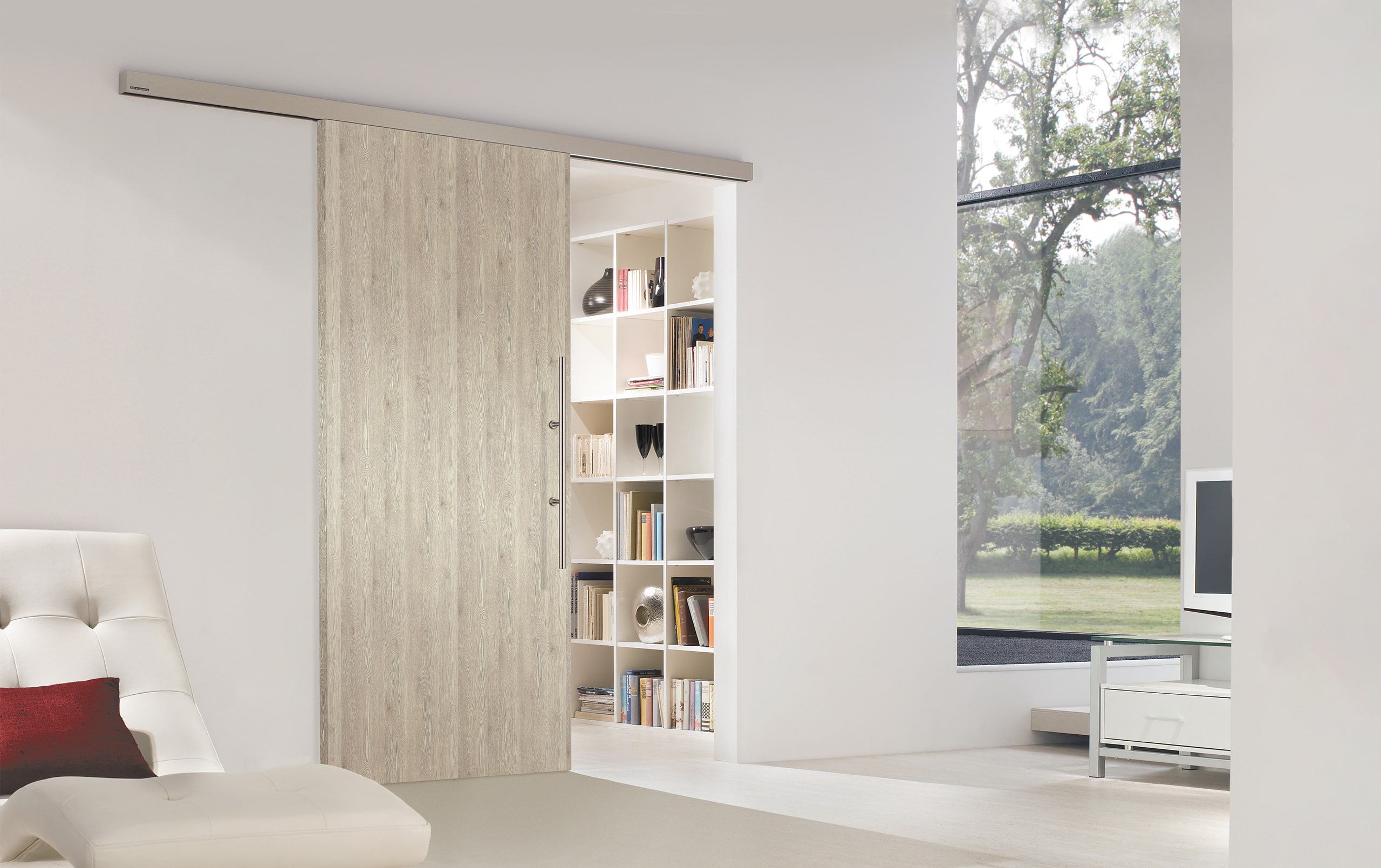
Sliding doors are a top choice for modern bathrooms. They save space and don’t need extra room to swing open. A glass sliding door or a metal-framed sliding door can give your bathroom a chic, streamlined look. The large glass panels allow light to flow through, making the space feel larger and more open.
2. Frameless Glass Doors:
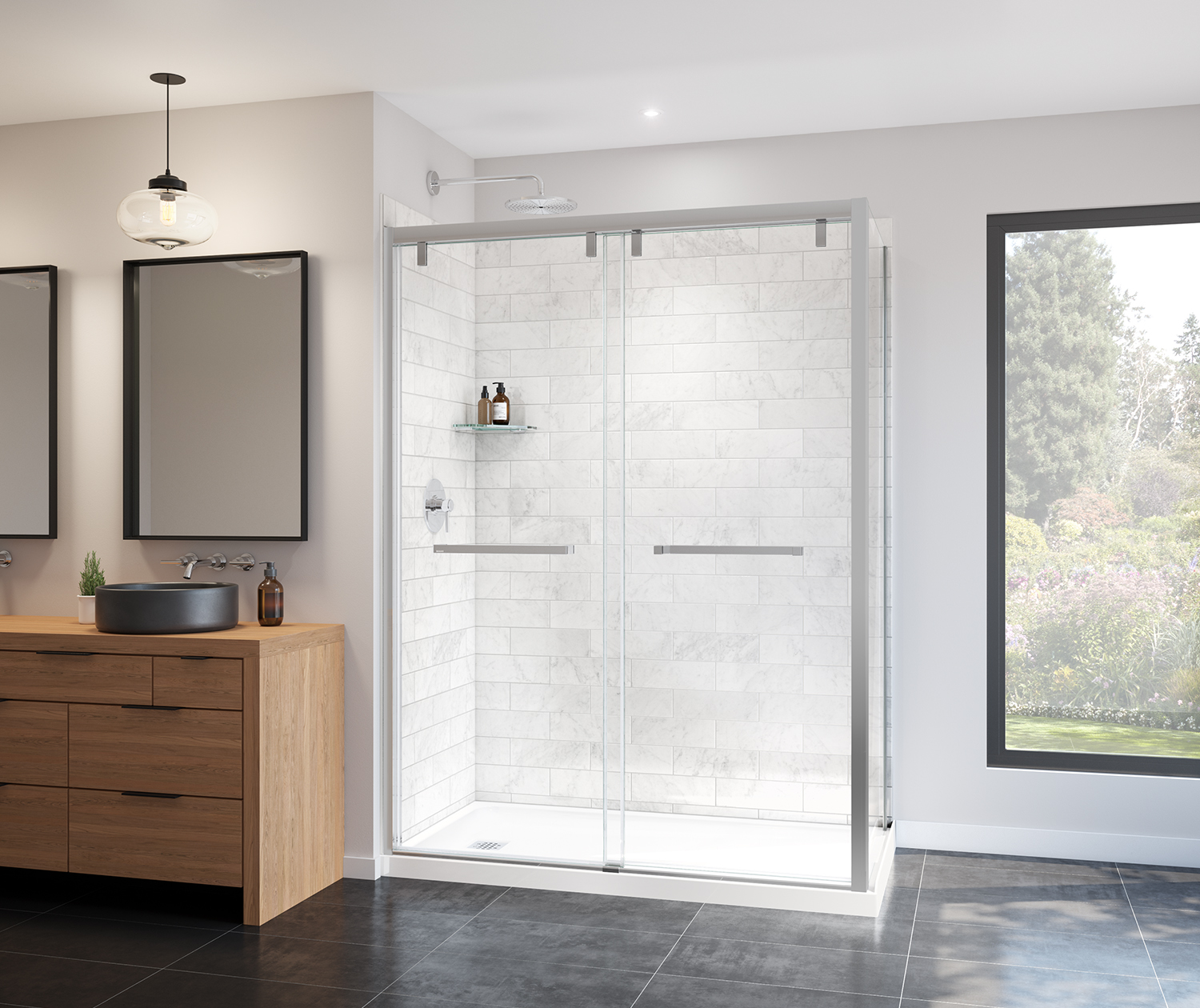
For a truly modern aesthetic, frameless glass doors are a stunning option. These doors have no metal frame, offering a clean, unobstructed view. Frameless glass works well in small and large bathrooms, especially with a glass-enclosed shower. This style gives a sleek, spa-like feel to the bathroom.
3. High-Gloss or Matte Finish:

Modern bathroom doors often feature high-gloss or matte finishes. A high-gloss finish can create a polished, reflective look, while matte doors provide a more subdued, contemporary vibe. Both options complement modern design trends, whether you’re working with minimalist or bold color schemes.
4. Pocket Doors:
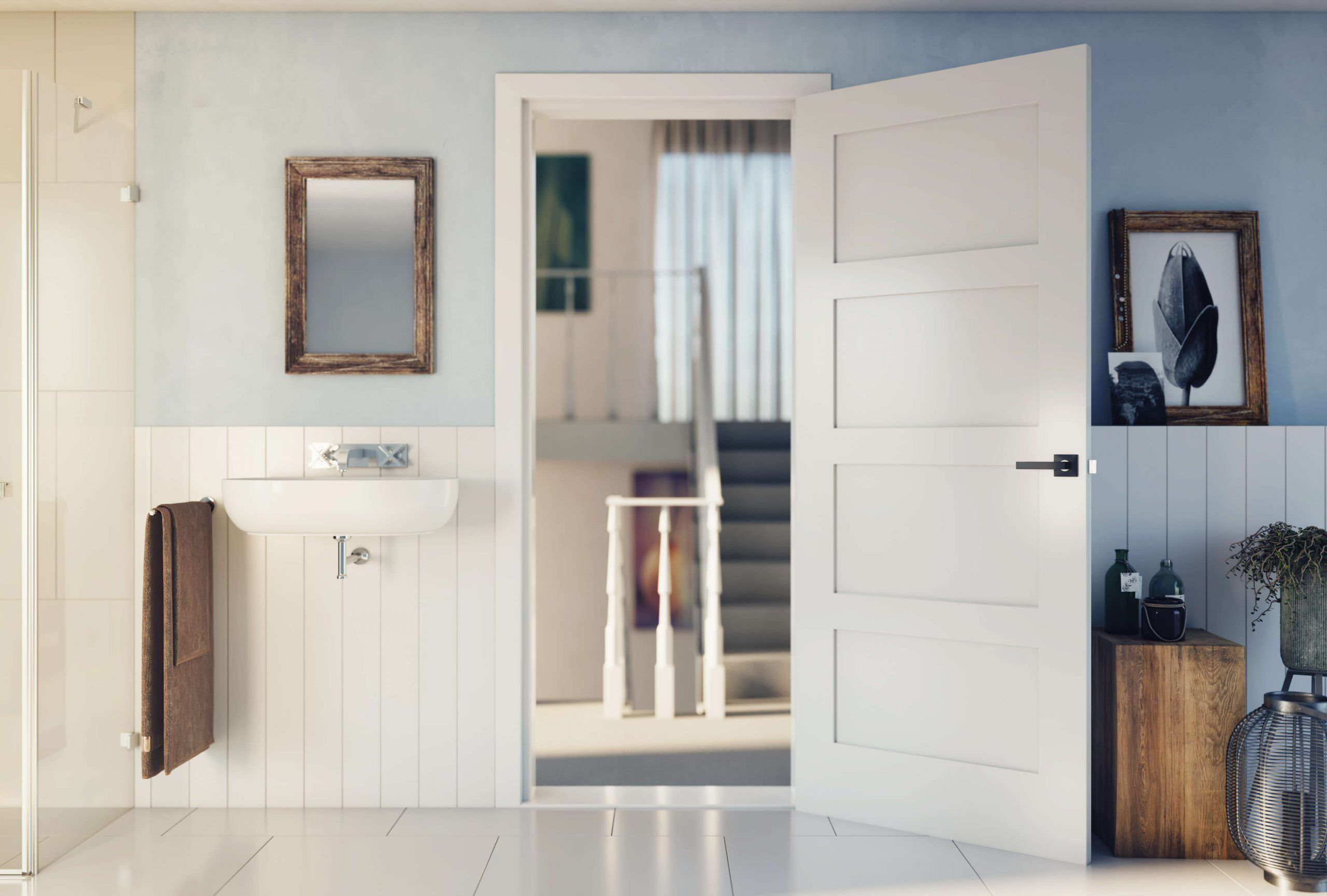
For a truly modern twist, pocket doors can be an ideal solution. When opened, these doors slide neatly into the wall, saving space and maintaining a sleek look. Pocket doors are especially effective in smaller bathrooms where every inch counts. They are also ideal for creating a clean, uncluttered look.
Classic and Traditional Bathroom Door Designs
If you aim for a timeless, elegant look, classic and traditional bathroom doors are the way to go. These doors feature rich materials and detailed designs that add warmth and character to your bathroom. Here are some traditional bathroom door styles:
1. Paneled Wooden Doors:
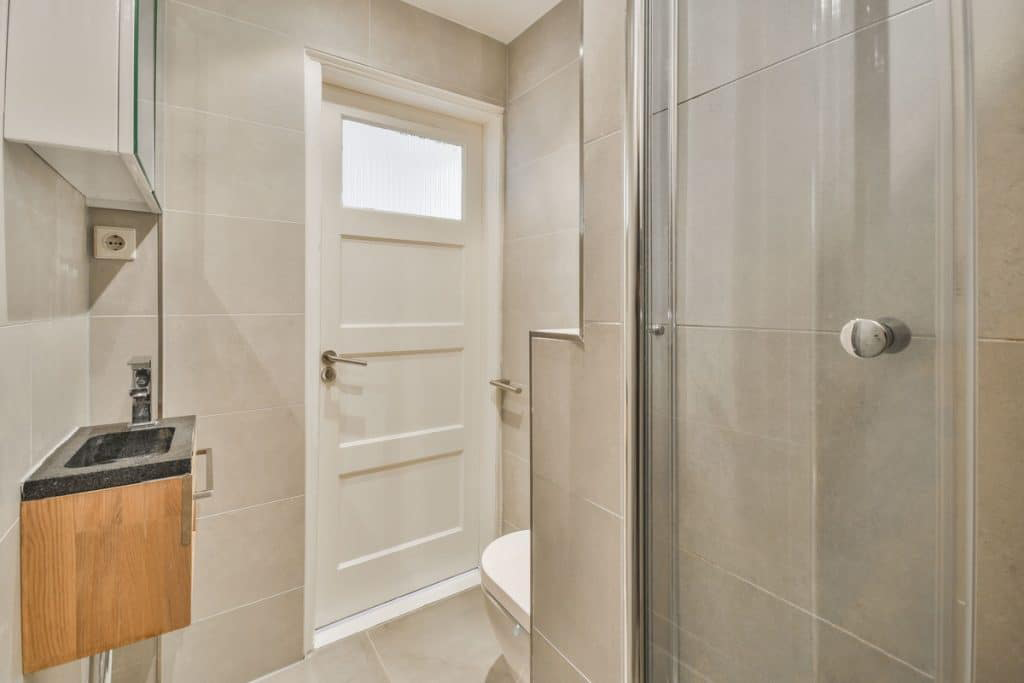
Wooden bathroom doors with classic paneling are a staple of traditional design. These doors typically feature panels or raised molding, adding texture and sophistication to your bathroom. Depending on your style, you can opt for a dark wood like mahogany for a formal look or light wood like oak for a warmer, more casual feel.
2. French Doors:
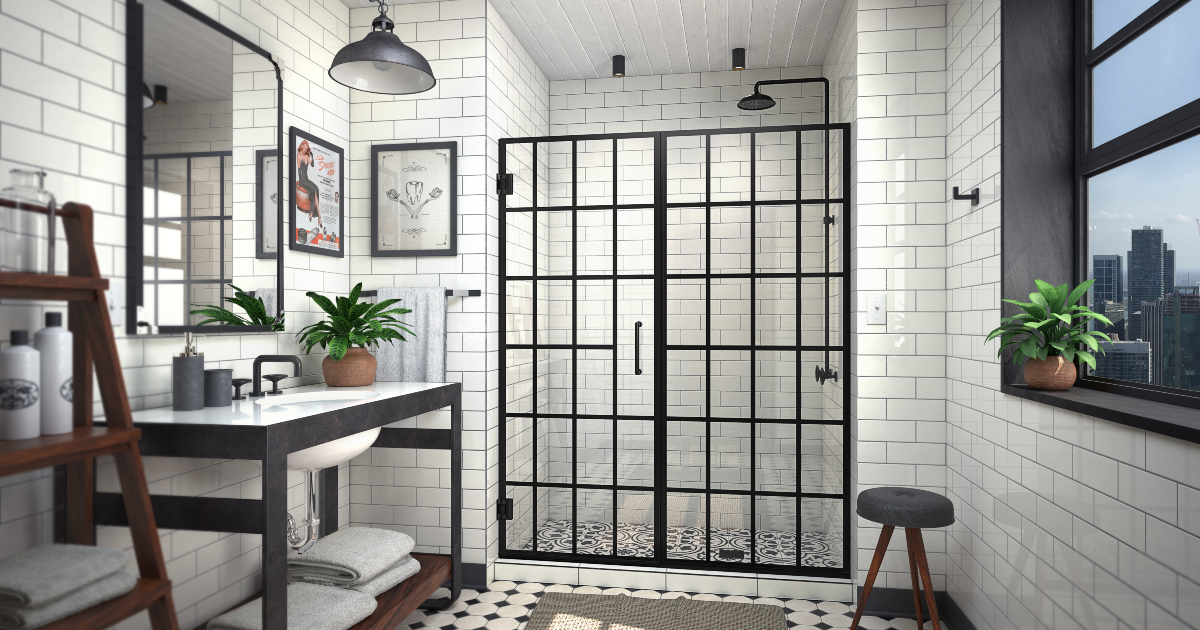
If you want to add a touch of elegance, French doors can be a stunning option for your bathroom. These doors have two panels with glass inserts, providing an airy, open feeling while maintaining privacy. They work particularly well in bathrooms with large windows or scenic views, allowing natural light to pour in. French doors also lend a luxurious, classic touch to any bathroom space.
3. Raised Panel Doors:
Raised panel doors are a common choice in traditional bathroom designs. The panels are set deeper than the surrounding door surface, creating an elegant, multi-dimensional look. This style is perfect for vintage or Victorian-inspired bathrooms and pairs well with ornate hardware like brass or bronze handles.
4. Double Doors:
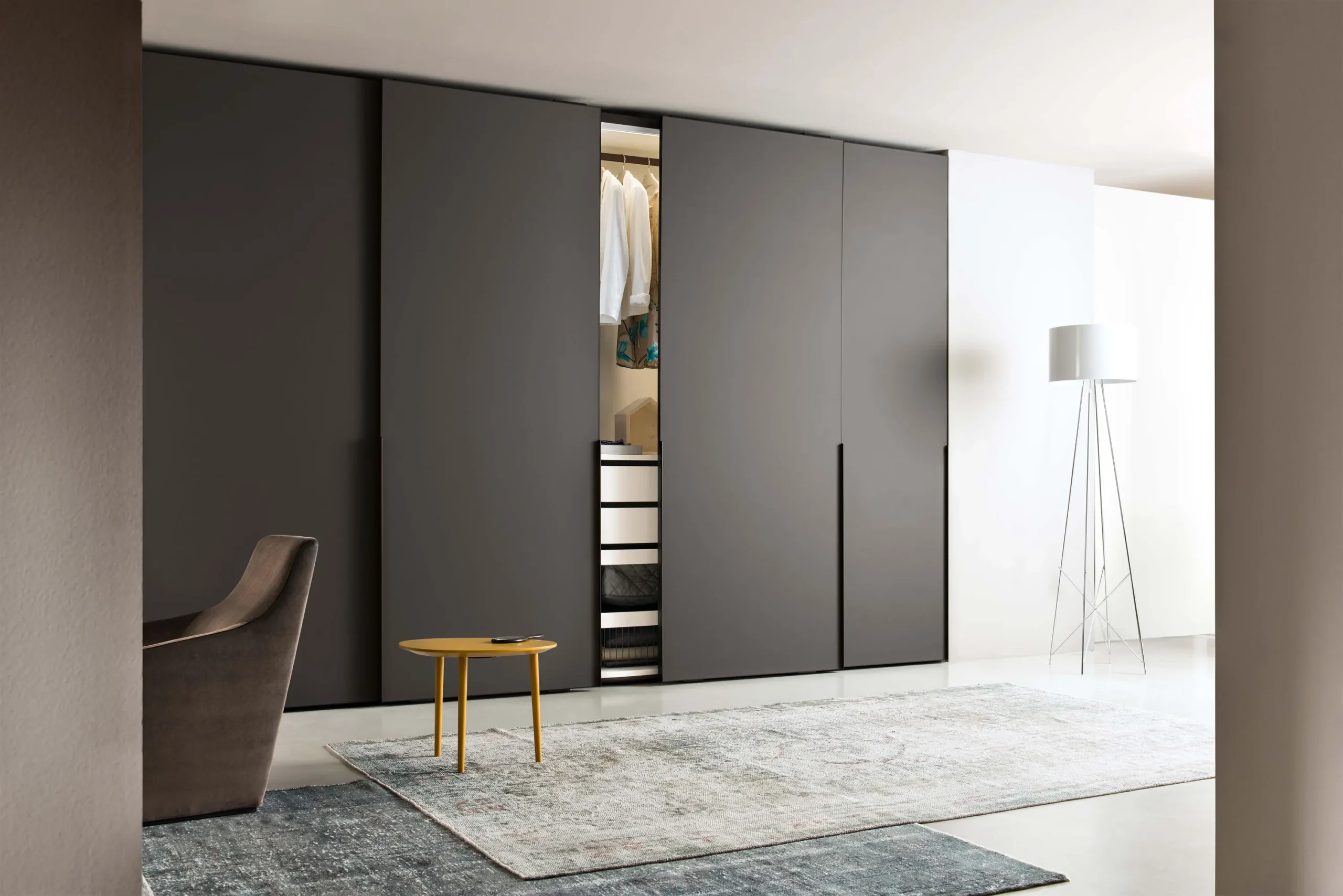
For larger bathrooms, double doors can make a bold statement. Traditional double doors with ornate carvings or glass inserts can add a sense of grandeur to your bathroom. This design is often seen in master bathrooms or a classic, regal style.
Rustic Bathroom Door Ideas
Rustic bathroom doors are a fantastic choice for a warm, inviting, and earthy feel. These doors are all about using natural materials and embracing imperfections. They work particularly well in bathrooms designed with natural stone, wood, or earthy tones. Here are a few rustic bathroom door ideas:
1. Barn Doors:
Barn doors have gained popularity in rustic design, and for good reason. These doors bring a rustic, farmhouse charm to the bathroom. They are often made of wood and slide across a metal track, adding function and style. A weathered wood barn door can give your bathroom a cozy, country feel, especially with rustic hardware like wrought iron handles.
2. Reclaimed Wood Doors:
If you want a truly rustic look, consider using reclaimed wood for your bathroom door. This style embraces the beauty of aged wood, showcasing its natural grains, knots, and imperfections. Reclaimed wood doors can be left in their natural state or stained for a deeper color. Either way, they add character and warmth to your bathroom space.
3. Knotty Pine or Cedar Doors:
Knotty pine or cedar doors can be a great option for a rustic cabin feel. These woods have distinctive knots and patterns that give them a unique, natural appeal. These doors are often left with a natural finish to highlight the wood’s texture, making them perfect for rustic bathrooms.
4. Shutter-style Doors:
Another charming rustic option is shutter-style doors, often seen in coastal or cottage bathrooms. These doors are typically wood-made and feature horizontal slats, allowing airflow. They work well in bathrooms with beachy or cottage-inspired themes, creating a relaxed, lived-in atmosphere.
5. Wrought Iron Accents:
Wrought iron can be incorporated into rustic bathroom doors if you’re going for a more rugged, industrial look. You can combine wrought iron with wood for a vintage, farmhouse-inspired design. The contrast of the dark metal with the natural wood creates a striking visual element, making it a great fit for rustic and industrial bathrooms.
How to Measure for the Perfect Bathroom Door?
Choosing the right bathroom door involves more than picking a style and material. Properly measuring the door opening is crucial to ensure that your door fits perfectly. Whether installing a standard door or opting for a custom design, accurate measurements will save you time, money, and frustration. In this section, we’ll guide you through the steps for measuring your bathroom door, covering both standard sizes and custom measurements.
Standard Door Sizes for Bathrooms
When shopping for a bathroom door, it’s essential to know the standard sizes that are typically available. Most bathroom doors are designed to fit common door openings, so knowing these dimensions will help you choose a door that fits well without needing modifications. Here are the most common standard bathroom door sizes:
1. Standard Door Height:
The standard height for bathroom doors is typically 80 inches (6 feet 8 inches). This is the most common door height for residential homes and works well for most bathroom spaces. It allows enough headroom while maintaining a proportionate look with the rest of the room.
2. Standard Door Width:
The standard width for bathroom doors is usually 24 inches, 28 inches, 30 inches, 32 inches, or 36 inches. The most common bathroom door widths are 30 inches and 32 inches. However, you may need a smaller door, like a 24-inch door, if your bathroom has a tight space or a smaller opening.
3. Door Thickness:
Most bathroom doors have a standard thickness of 1 ⅜ inches. However, some doors, especially custom or heavier models, can be thicker. Check the thickness if you’re buying a door with a solid core for added privacy or soundproofing.
4. Consider the Frame:
In addition to the door itself, you’ll need to measure the door frame to ensure it fits within it. The frame’s dimensions include the width and height, plus an allowance for the hinges and space for opening and closing.
If your bathroom door fits within the standard dimensions mentioned above, you’ll have a harder time finding a pre-made door that works. If not, you may need to consider custom options.
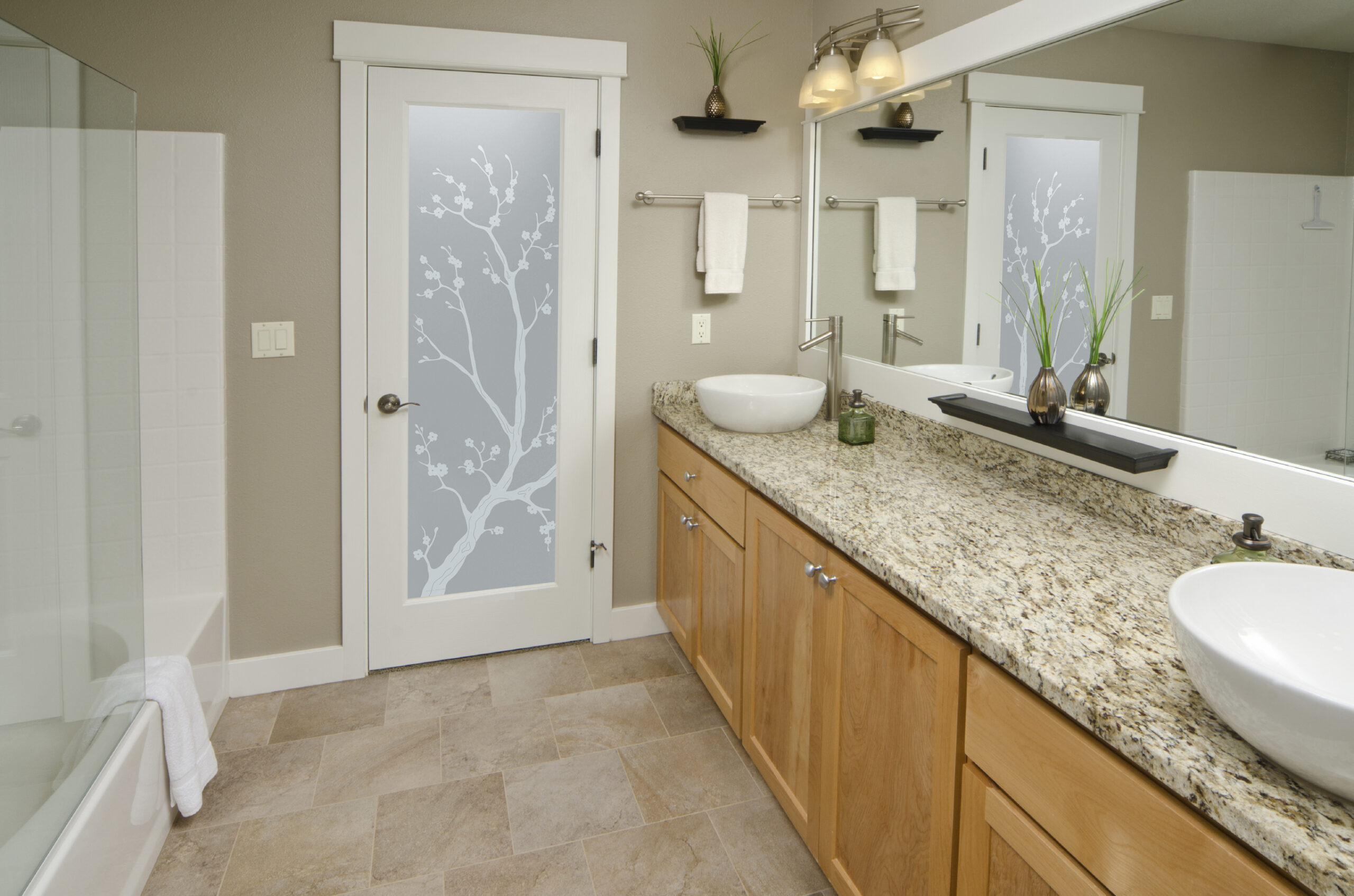
Measuring for Custom Bathroom Doors
If your bathroom has an unusually shaped doorway, or you’re looking for a unique door style, custom bathroom doors might be the way to go. Custom doors allow you to choose specific materials, designs, and sizes to fit your bathroom perfectly. However, measuring for a custom door requires more attention to detail. Here’s how to measure for a custom bathroom door:
1. Measure the Door Opening (Height and Width):
First, measure the height and width of the door opening. Start by measuring the width at three points: the doorway’s top, middle, and bottom. This ensures your door fits the space, as some doorways may be slightly out of square. Use the smallest measurement as the width for the door.
Next, measure the opening height from the floor to the top of the frame. Ensure to measure from the highest point, as some floors may be uneven. If your floor has a baseboard, you should subtract a small amount from the height to account for clearance between the door and the floor.
2. Measure the Door Frame Depth:
For a custom door, it’s also essential to measure the frame depth. This refers to how thick the door frame is, which impacts the type of door you choose. Most door frames are around 4 ½ inches thick, which can vary. A deeper frame may require a thicker door, while a shallower frame could work with a thinner one.
3. Check for Obstructions or Hinges:
When measuring for a custom bathroom door, take note of any obstructions around the door, such as light switches, towel racks, or plumbing pipes. These could interfere with the installation of your new door. Measure the distance between the opening and any obstructions to ensure the door has enough clearance to swing open or close without hitting anything.
Also, measure the hinge placement to ensure the door opens and closes properly. The most common hinge positions are left-handed or right-handed, so plan accordingly, depending on which direction you want the door to swing.
4. Allow for Proper Clearance:
For a proper fit, leave some space between the door and the frame to allow for the door to open and close smoothly. This is especially important for wooden doors, which can expand and contract due to changes in humidity. A standard clearance for a bathroom door is typically around 1/8 inch at the top and sides. Also, leave a small gap at the bottom to allow air circulation.
5. Double-Check Your Measurements:
Before ordering your custom bathroom door, double-check all of your measurements. It’s easy to overlook small details or make an error while measuring. Accurate measurements ensure your new door will fit as intended, avoiding the need for adjustments or costly mistakes later.
Tips for Successful Bathroom Door Installation
Once you’ve measured your bathroom doorway, planning the installation process carefully is important. If you’re not experienced in door installation, hiring a professional to ensure your bathroom door is fitted properly might be best. Incorrect installation can lead to poor door function, such as sticking or misalignment, which can become a hassle over time.
1. Professional Help:
If you’re opting for a custom bathroom door or a more complicated door style, like a sliding door or a bi-fold door, consider hiring a professional installer. Their experience will ensure that your door fits perfectly and functions smoothly.
2. Consider Door Hardware:
Don’t forget about the hardware—locks, handles, and hinges—when measuring for a new door. The hardware plays a significant role in the door’s functionality and appearance. Be sure to select hardware that complements the style and material of your bathroom door.
Bathroom Door Installation: What You Need to Know
Installing a new bathroom door can be a rewarding home improvement project but requires careful planning and the right tools. Whether you opt for a standard, sliding, or pocket door, understanding the installation process is key to a smooth and successful outcome. In this section, we’ll explore the differences between DIY and professional installation, the costs involved, and offer tips for installing more complex doors like sliding or pocket doors.
DIY vs. Professional Installation
When installing a bathroom door, you have two main options: DIY installation or hiring a professional. Both have their pros and cons, depending on your skills, budget, and the complexity of the door you’re installing.
DIY Installation:
If you’re comfortable with basic tools and have some experience with home improvement, you should tackle the installation yourself. Here’s what you’ll need to know:
- Tools Required: You’ll need a tape measure, level, screwdriver, hammer, drill, and possibly a saw, depending on whether you need to trim the door to fit.
- Time Commitment: DIY bathroom door installation can take a few hours to a full day, depending on the door type and whether you’re making any adjustments to the frame.
- Skills Needed: Installing a basic swing or sliding door is fairly straightforward. However, pocket doors, bi-fold doors, and custom designs can be more challenging, requiring more advanced skills.
- Cost Savings: By doing it yourself, you can save on labor costs, which can add up quickly. However, be sure to factor in the cost of tools and any materials you need.
Professional Installation:
Hiring a professional for bathroom door installation offers several benefits, especially for more complex door styles like pocket doors or sliding doors.
- Expertise: Professionals are skilled at handling various door types and have the experience to ensure that your bathroom door is properly aligned, sealed, and functions smoothly.
- Time Efficiency: While DIY installation can take several hours, a professional can often complete the job in a fraction of the time. This is especially helpful if you’re on a tight schedule.
- Quality Assurance: A professional installer can ensure the door is installed correctly, preventing issues like poor sealing, misalignment, or hardware failure that could occur with a DIY installation.
Cost of Installing a Bathroom Door
The cost of installing a bathroom door can vary depending on several factors, including the type of door, the materials, and whether you opt for DIY or professional installation. Here’s a breakdown of what to expect:
1. Door Price:
The price of a bathroom door itself can range widely based on material, style, and size. On average:
- A basic wooden door can cost anywhere from $50 to $200.
- Glass doors (clear or frosted) can range from $150 to $500 or more, depending on the quality of the glass and the frame.
- Sliding or pocket doors are generally more expensive, ranging from $200 to $600, requiring specialized hardware and framing.
2. Professional Labor Costs:
If you hire a professional to install your bathroom door, expect to pay for labor and materials. The average cost for labor alone typically ranges from $100 to $300, depending on the complexity of the job and the region. For example:
- Basic installations (swing doors, basic glass doors) may cost around $150 to $200 for labor.
- Sliding and pocket doors could cost more due to their complexity, with installation labor fees ranging from $250 to $500.
3. Additional Costs:
Additional expenses may include:
- Hardware: Hinges, handles, locks, and other accessories can add $20 to $100 to the cost.
- Frame Modifications: If the door frame needs adjustments or repairs, this could add another $100 to $300.
- Permits: In some cases, especially with custom designs or structural changes, you may need a permit for installation, which can cost between $50 and $150.
Tips for Installing a Sliding or Pocket Door
Sliding and pocket doors are popular for bathrooms, especially in smaller spaces, as they save room and add a modern touch. However, installing these doors requires careful planning and attention to detail. Here are some tips for successfully installing either type of door:
1. Sliding Door Installation Tips:
- Measure Twice, Cut Once: Sliding doors typically require a precise measurement of both the door opening and the track system. Ensure that the track is level to avoid the door becoming misaligned.
- Track Placement: The track should be mounted securely to the top of the doorway. You may also need a bottom track or guide to stabilize the door when it slides open and closed.
- Choose the Right Door Material: Glass or lightweight wood doors work best for a sliding bathroom door, as they are easier to slide and won’t put too much strain on the track system.
- Check for Clearance: Ensure enough space for the door to fully open without hitting any obstructions, such as shelves or furniture.
2. Pocket Door Installation Tips:
- Wall Space: Pocket doors require a hollow wall cavity to slide into. If your bathroom doesn’t have this, you may need to remove part of the drywall or framing. This can be a more complicated installation, which may require professional help.
- Use a Pre-Frame Kit: Many companies offer pre-frame kits that include all the necessary components for installing a pocket door. These kits help simplify the process and ensure the door fits correctly.
- Ensure Smooth Operation: Pocket doors can be prone to sticking if not installed properly. Be sure to check that the track is level and that the door slides smoothly along the guide.
- Hidden Mechanism: One of the main benefits of a pocket door is its hidden design. However, if you plan to install a custom or heavy door, ensure the track system is robust enough to handle the weight.
Relate FAQ
Can I use a regular door for my bathroom?
While you can use a regular door for a bathroom, it’s better to choose one specifically designed for high humidity. Regular doors might warp, swell, or lose their finish due to the moisture in a bathroom. Choosing materials like fiberglass, PVC, or moisture-resistant MDF is recommended for better longevity.
Are glass doors a good choice for bathrooms?
Glass doors can be an elegant and modern bathroom choice, especially for shower enclosures. However, consider frosted or opaque glass for full bathroom entry doors to ensure privacy. Tempered glass is necessary for safety. Glass doors should also be maintained regularly to avoid water spots and streaks.
What door style is best for a small bathroom?
For small bathrooms, bi-fold doors or sliding doors are great space-saving options. They don’t require the clearance of a traditional hinged door, allowing for more usable space in your bathroom. Sliding barn doors can also add a rustic touch to your decor.
What color should a bathroom door be?
The color of a bathroom door should complement the overall design of your bathroom. Neutral tones like white, grey, or beige are popular as they create a clean, fresh look. However, bold colors or custom designs can work well for contemporary or more personalized bathroom styles. Ensure the door color coordinates with other room elements, such as tiles and fixtures.
How do I prevent my bathroom door from swelling or warping?
Choose moisture-resistant materials, like fiberglass, PVC, or specially treated wood, to prevent your bathroom door from swelling or warping. Ensure the door is properly sealed around the edges and avoid direct water exposure. Installing a bathroom fan can also help reduce humidity levels, preventing excessive moisture buildup.
Should a bathroom door open in or out?
Ideally, a bathroom door should open outward in emergencies, as this offers easier access. In smaller bathrooms, however, an inward-opening door may be necessary to save space, but it’s important to check that it doesn’t block fixtures or impede movement.
What is the best door for a bathroom with high humidity?
Fiberglass or PVC doors are the best choices for bathrooms with high humidity. These materials are highly resistant to moisture and will not warp or deteriorate. A glass door with proper seals can also work as long as it’s treated for moisture control.
How much does a bathroom door cost?
The cost of a bathroom door can vary greatly depending on the material, style, and size. Basic hollow-core doors may cost $50 to $150, while higher-end options like solid wood, fiberglass, or custom designs may range from $200 to $500 or more. Adding glass panels or special finishes will increase the cost.
Can a bathroom door be soundproof?
Yes, bathroom doors can be soundproofed using solid-core doors or adding a layer of soundproofing materials like acoustic panels or weatherstripping. Solid doors provide better privacy by reducing noise transmission.
What type of door handle is best for a bathroom door?
When choosing a door handle for a bathroom, it’s essential to opt for one that resists moisture and is easy to clean. Stainless steel or brushed nickel handles are popular because they don’t rust and match various bathroom styles. Lever handles or knobs with a sleek design are both functional and aesthetic.
Share This Story, Choose Your Platform!
Send Us A Message
*100% Privacy Guaranteed



